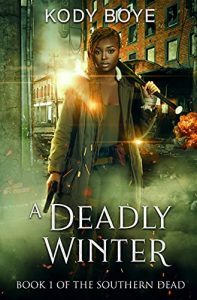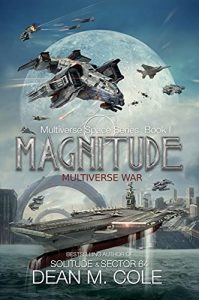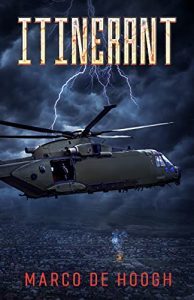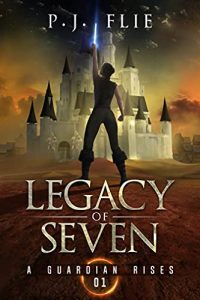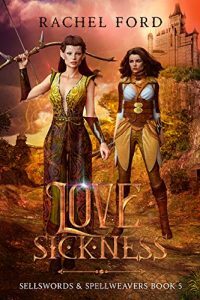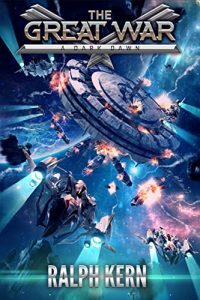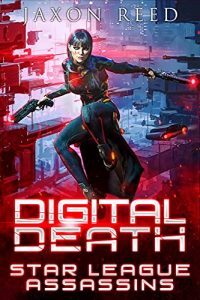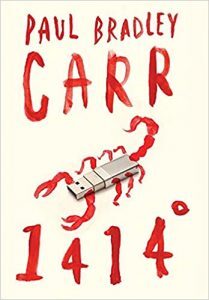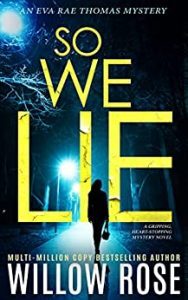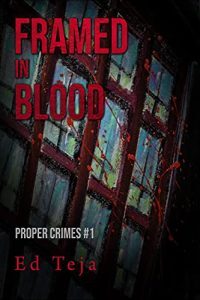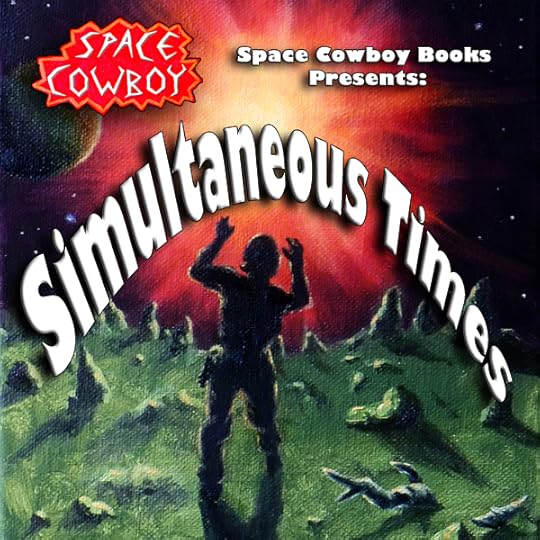Cora Buhlert's Blog, page 35
October 31, 2021
First Monday Free Fiction: A Grave Case
 Welcome to the November 2021 edition of First Monday Free Fiction, which goes out on a Tuesday, because I was really busy yesterday and just forgot to post this.
Welcome to the November 2021 edition of First Monday Free Fiction, which goes out on a Tuesday, because I was really busy yesterday and just forgot to post this.
To recap, inspired by Kristine Kathryn Rusch who posts a free short story every week on her blog, I’ll post a free story on the first Monday of every month. At the end of the month, I’ll take the story down and post another.
November 1 is All Hallows’ Day and November 2 All Souls’ Day, which are traditional days to honour and remember the dead, so what could be a more perfect story for this day than A Grave Case, a murder mystery set at a cemetery.
So accompany Detective Inspector Helen Shepherd and her team, as they investigate…
A Grave CaseDetective Inspector Helen Shepherd parked her battered Vauxhall on the parking lot just off Harrow Road and walked up to the main gate of Kensal Green cemetery.
As she passed through the gate with its faux Grecian columns, she suppressed an involuntary shudder. She’d never liked cemeteries, not even during her misspent punk youth. You’d think that an aversion to cemeteries would be a hindrance for an officer of the Homicide and Serious Crimes Command. You’d be wrong, though, because normally Helen and her colleagues solved the murder long before the funeral, so there was no need to visit a cemetery.
Unless the cemetery was the crime scene, that was.
And the murderer couldn’t even find themselves a nice small graveyard to commit the dastardly deed — no, they had to pick one of London’s biggest cemeteries. For Kensal Green was huge. Huge and full of famous corpses. Freddy Mercury was buried here, Charles Babbage, Ingrid Bergman, Alan Rickman, Christine Keeler, Anthony Trollope, Wilkie Collins, William Makepeace Thackeray, Harold Pinter, Sax Rohmer, a famed highwire artist who crossed Niagara Falls, a nephew of Napoleon Bonaparte, an Indian maharani and several lesser members of the royal family. As well as thousands of unknown folks, including Helen’s Aunt Mabel and Uncle Horace.
Helen suspected that she could still find her way to Aunt Mabel and Uncle Horace’s grave, though she hadn’t been there in ages. But unfortunately, that did not help her find the crime scene.
“Near the Anglican chapel,” the dispatcher had said. So Helen glanced at the signpost and directed her steps that way. She strutted briskly along the path, gravel crunching under her heels.
She did not have long to search. The chapel with its neo-classical columns was looming in the distance when Helen spotted two uniforms loitering among the trees and gothic gravestones.
The uniforms nodded to her, as they lifted the police tape to let Helen through.
“Good morning, Inspector. It’s a bit further down. Turn right at the ivy covered mausoleum, then pass between the weeping angel and the gothic stele and you should find it.”
So Helen picked her way across the uneven ground (“Do not think about why it is so uneven!”). She spotted the mausoleum up ahead, turned to the right, found the weeping angel (“Wasn’t there a Doctor Who episodes about such statues coming alive and killing people?”) and what she assumed was a gothic stele. It did look gothic, at any rate.
Among the graves, she spotted Detective Constable Kevin Walker and Police Constable Martin Jackson. They were both sipping coffee from paper cups, while chatting with a woman Helen did not know.
Helen sighed. She should have gotten herself a coffee. Especially since she’d passed a few coffee shops and bakeries on the way here, including one that was almost directly opposite the cemetery gates.
By now, DC Walker had spotted Helen and waved. So Helen made her way over, wondering whether PC Jackson or one of the other uniforms might be persuaded to head to one of the coffee shops on Harrow Road and fetch her a coffee.
Still, first things first. She nodded at Walker and Jackson. “Good morning, Constables.”
“Hello, Inspector,” DC Walker said. A bit of milk foam clung to his upper lip, obscuring the freckles that dotted his pallid skin.
“Good morning.” PC Jackson raised his cup and grinned, his teeth stark white in his dark face.
“This is Detective Constable Laila Kermani of Harlesden Police Station,” DC Walker introduced the woman next to him. She was about thirty, with brown skin, dark eyes and long black hair she wore tied into a braid at the nape of her neck.
DC Kermani held out her hand. “I’m so glad you’re here, Inspector,” she said, “Maybe now someone will finally take this case seriously. Though it’s a shame that this poor woman had to die first.”
Helen had no idea what DC Kermani was talking about.
“Maybe you could start by telling me what exactly we’re dealing with here,” Helen said.
DC Walker shifted the coffee cup to his other hand and consulted his trusty notebook. “Maureen Pettigrew, aged seventy-eight,” he rattled off, “Found dead on the grave of her late husband Ronald Edward Pettigrew.”
“I assume she did not die of a broken heart.”
“No, boss, she had her skull bashed in,” DC Walker announced with inordinate cheerfulness.
“The victim’s handbag and jewellery are missing,” PC Jackson added.
“Looks like a robbery gone wrong then,” Helen said.
“It was a robbery,” DC Kermani announced, “And it’s not the first time something like this has happened, though it’s the first time someone died.”
Helen shot her a questioning look.
“These past few weeks, we’ve been experiencing a wave of robberies on the cemetery grounds.”
“How many robberies have there been?” Helen asked.
“Eight that we know of, including poor Mrs. Pettigrew.”
“And you’re sure it’s the same person?”
DC Kermani nodded. “Absolutely sure. The modus operandi is always the same. Elderly people, mostly women, are attacked from behind, knocked out and robbed of their valuables. So far, none of the victims have been able to identify their attacker.”
“I assume this was your case before we were called in?”
Once again, DC Kermani nodded. “I’ve been trying to get my superiors to take these robberies seriously and authorise a covert operation to apprehend the culprit. After all, three women and one man, all in their seventies and eighties, had to be hospitalised following the attacks. It was only a matter of time until this bastard — pardon, my language — killed someone.” DC Kermani lowered her eyes. “And now he did.”
“Do you have any suspects?” Helen wanted to know.
DC Kermani shook her head. “Not really. The caretaker, one Harold Cummins, claims he has seen a scruffy young man skulking around the cemetery.”
“Mr. Cummins was also the one who found the victim and called us,” PC Jackson added.
“Where is he now?”
“Waiting in the caretaker’s lodge with a uniform,” DC Walker replied, “Do you want to talk to him, boss?”
“Later. First, I want to take a look at the crime scene and the victim.”
***
Kensal Green cemetery had plenty of graves with ornate headstones, but Ronald Pettigrew’s was not one of them. His headstone was plain grey granite with his name, birth and death date neatly chiselled into the stone. Helen glanced at the dates. Ronald Pettigrew had died six months before, aged eighty-three.
His widow Maureen lay face down on her late husband’s grave, her nose in a pot of purple petunias. Dried blood stained her white hair and camel hair coat. A cellophane wrapped bouquet of red carnations lay next to the body.
“I guess the cause of death is not much of a mystery,” Helen remarked.
Doctor Rajiv, the forensic pathologist, looked up from where he was kneeling next to the victim. Dark eyes gleamed behind gold-rimmed glasses.
“Well, we have to wait for the post-mortem, of course, but the initial examination suggests that Mrs. Pettigrew died after being bludgeoned with a blunt object.”
“Do you have any idea what the weapon was, Doctor?”
Doctor Rajiv shook his head. “Not exactly. Though I have found gravel and soil in Mrs. Pettigrew’s head wound, which suggests the object was something the perpetrator found here at the cemetery.”
“Maybe I can help,” Scene of the Crime Officer Charlotte Wong announced. She got up, the knees of her white coverall stained with grave dirt. She did not look particularly enticing, but DC Walker grinned at her anyway. The two of them had been dating for a while now.
“I found a chunk of granite, most likely a fragment of a gravestone, over there.” Charlotte pointed at the grave with the weeping angel. “It was stained with blood. We’ll have to wait for the post-mortem, of course, but…” Charlotte Wong held up an evidence bag containing a bloodstained rock. “…most likely this is the weapon the attacker used.”
“Excellent,” Helen said, “So we have the murder weapon. Do we have any prints?”
Charlotte Wong shook her head. “It’s weathered granite. Not very good for retaining fingerprints. The blood stains are also smeared, suggesting that the attacker tried to wipe off the rock before discarding it.”
“Ah well, that would have been too easy. Do we have anything else?”
Charlotte beamed. “We have footprints, some of them quite clear. Looks like workboots, size 8.”
Helen gave her an appreciative nod. “Now that’s helpful. If you find anything else, let me know.”
“Inspector…?”
Helen turned around and found herself face to face with DC Kermani. “Yes, Constable?”
“With the previous robberies, the stolen handbags and wallets sometimes showed up again in garbage bins around the cemetery. Without the valuables, of course.”
“And you think the perpetrator might have discarded Mrs. Pettigrew’s handbag as well?” Helen asked.
“It’s worth a try, at any rate.”
“Good thinking, Constable. Have some uniforms search the bins. Maybe we’ll get lucky.”
As DC Kermani left to organise the search, PC Jackson picked his way through the graves.
“Inspector, we have some potential witnesses,” Jackson announced, “A couple of goth kids. They say they’re students and were filming a horror movie here. They claim they haven’t seen anything, but…”
At the word “filming,” Helen’s eyebrows shot up. “But they have video footage of the cemetery shot around the time of the murder?”
Jackson nodded.
“All right, keep the kids here. I’ll question them later. And we need that video footage. Maybe they filmed the murder or the murderer and don’t even know it.”
“On it, Inspector,” Jackson said and took off.
DC Walker looked after him. “What now, boss?”
“Now we’ll question the caretaker.”
***
The caretaker’s lodge turned out to be a surprisingly cosy looking Victorian cottage next to one of the cemetery entrances, It would have been a highly desirable piece of real estate, if not for the fact that it was located right beside one of London’s biggest cemeteries.
The caretaker himself, Harold Cummins, was sitting at a table in a small kitchen, while a bored looking police constable was lounging in the corner. Cummins was a white man in his late fifties, gone prematurely grey and looking permanently worried. He was fidgeting with a pack of cards and looked up as Helen entered, Constables Walker and Kermani on her heels.
“Finally,” he snapped, “I have to be about my business, you know, instruct the gardeners, make sure the bins are emptied. Plus, we have two memorial services today at eleven, one in the Anglican chapel and another at St. Mary’s Catholic chapel and someone needs to make sure that everything’s ready.”
Helen interrupted his diatribe. “I apologise for keeping you waiting, Mr. Cummins,” she said smoothly, “And I assure you, we will be as brief as possible. However, this is a murder inquiry, so I fear your other duties will have to wait.”
Cummins scowled and glared at DC Kermani. “Well, if she had arrested that young never-do-well I pointed out to her, we wouldn’t be in this mess and that poor woman would still be alive.”
Helen made a mental note to ask DC Kermani about “that young never-do-well” — later. For now, she turned to the police constable in the corner. “Would you be so kind to fetch some coffee for Constables Walker and Kermani, Mr. Cummins here and myself?” She handed the man a twenty pound note. “I think I spotted a café right across Harrow Road.”
The police constable saluted and left, clearly glad to have gotten out of dull guard duty.
“I don’t need a coffee,” Harold Cummins mumbled to no one in particular, “I really need to go. The bins…”
“Will have to wait,” Helen said firmly. She settled down at the table, careful not to touch the grubby, red and white chequered wax cloth that covered it.
“I understand that you found the victim, Mr. Cummins.”
Cummins nodded. “During my round this morning. I spotted her lying on the ground and went over to see if I could help. At first I thought that she stumbled and fell — it happens sometimes with old people. But then I came closer and saw the blood. So much blood.” He shuddered at the memory.
“Did you touch the body?” Helen wanted to know.
Cummins rubbed his hands, like Lady Macbeth trying to remove non-existent bloodstains.
“I… I might have,” he hedged, “I had to check for a pulse, see if she was alive or dead. Is that bad, Inspector?”
“Well, it’s not ideal, but completely understandable under the circumstances,” Helen replied soothingly.
“And if Mrs. Pettigrew had been still alive, she would have needed medical attention fast,” DC Walker added.
“However, if you touched the body, one of our forensics specialists will have to take a DNA sample from you, so we can exclude you from our investigation,” Helen continued.
At the mention of the word “DNA sample,” Cummins blanched, but quickly caught himself.
“Of course, Inspector. Anything I can do to help.” He shook his head. “That poor woman.”
“Did you see anybody else in the cemetery this morning?” Helen wanted to know, “Anybody who behaved suspiciously perhaps?”
“Oh, you can bet that I did. It was that young fellow again. The one who’s always skulking around the cemetery. I told her…” Cummins glared at DC Kermani. “…about him, but she never did anything about it.”
“You must forgive us, but DC Walker and I are new to the case, so could you please repeat what you told DC Kermani about this young fellow?”
Harold Cummins, shifted in his chair, clearly about to launch into a longer tirade.
“I first noticed him four or five weeks ago, around the time the muggings started. Young fellow, jeans, leather jacket, long hair. It was obvious he was up to no good.”
“How can you tell?” DC Walker wanted to know.
“I’ve been working here at Kensal Green for thirty-five years now,” Cummins replied, “And in thirty-five years, you develop an eye for who belongs and who doesn’t. First, there’s the recently bereaved. They come a lot, every week, sometimes even every day. They bring flowers, keep the grave clean, sometimes just sit there and talk to the gravestone. Almost all are elderly, most are women. Younger people, they mourn, too, but they don’t go to the cemetery that often…”
Elderly women, recently bereaved. Exactly like Marjorie Pettigrew and the other victims of the cemetery mugger.
“Then there’s the anniversary people. They come once or twice a year, when it’s the deceased’s birthday or anniversary. They bring flowers, too, and clean up the grave, but just on those one or two days. Otherwise, they can’t be bothered.”
Harold Cummins shook his head, as if he couldn’t quite believe that there were people in the world who had neither the time nor inclination to visit a cemetery every day of their lives.
“Then there’s birdwatchers and photographers who take pictures of the many striking monuments we have here.”
Cummins beamed with pride.
“They’re odd but harmless. Then there’s the tourists who want to see the famous graves. All right, mostly just one. Freddie Mercury. We have royalty here, scholars, poets, playwrights, scientists, politicians. And who do the tourists want to see? Some fag of a singer. And then they always complain that they can’t find him. Cause he’s not buried here as Freddie Mercury, but under his real name, Farrokh Bulsara.”
Cummins shook his head.
“As if there ever was anybody who was really called Mercury. That’s a planet, not a name…”
At this moment, the door opened and the police constable returned, bearing a tray with coffee for everybody.
“Thank you, Constable.”
Helen took the tray and the change from the man. She handed a paper cup of coffee each to DC Walker and DC Kermani, set down a cup in front of Harold Cummins and kept the last one for herself.
“I don’t want any coffee,” Cummins said once more, “I really need to empty to bins and make sure everything is ready for the memorial services at eleven.”
“And I assure you, we won’t keep you any longer than necessary,” Helen said.
She took a sip of coffee, savouring the taste and the caffeine that shot into her veins, instantly making her more awake, more alert.
She turned back to Harold Cummins, who hadn’t touched his coffee yet. “All right, Mr. Cummins, where were we? Oh yes, you were just telling us about a suspicious young man you observed.”
As well as ranting about Freddie Mercury and the fact that tourists dared to want to see his grave rather than that of some long dead dignity. And muttering about bins. Cummins was oddly obsessed with emptying the bins.
“Like I said, Inspector, after thirty-five years, you can instantly tell who belongs and who doesn’t. The mourning relatives, the anniversary folks, the birdwatchers and photographer, even the tourists, they all belong.”
Harold Cummins finally did take a sip of coffee.
“And then there are the ones who don’t belong. Like those bloody goth kids who want to have parties in the mausoleums by night or do fashion shoots and movies or just ‘feel their mortality’. I always chase them away. Ghouls, that’s what they are. Ghouls and vampires without an inch of respect.”
“I understand there was a group of such goth kids in the cemetery this morning,” Helen probed.
“Oh yes, them.” Cummins spat derisively. “I had to remind them of the cemetery regulations. Again. If I didn’t have to chase them around, maybe I could have saved that poor woman.”
Cummins face suddenly took on a stricken look.
“Anyway, that young fellow I mentioned. He doesn’t belong. You can tell by the way he moves, skulking furtively, sticking to the shadows, slinking away whenever I walk past.”
“It’s not actually illegal to furtively skulk, stick to the shadows and slink away,” DC Walker pointed out.
“Maybe not,” Cummins replied, “But as far as I am concerned, it damn well should be.”
“Did you ever see that young man do anything do anything suspicious?” Helen asked, “Anything other than skulking, slinking and sticking to shadows?”
Harold Cummins scratched his head. “Well, not exactly,” he finally said, “But the way he behaves, it simply is suspicious.”
“Did you see him today?” Helen wanted to know.
Cummins scrunched his forehead, thinking hard. “Yes, he was here. I spotted him while I was chasing those goth kids.”
“Was he in the part of the cemetery where Mrs. Pettigrew was killed?” DC Walker asked.
Once more, Harold Cummins seemed to think hard. “Yes, he was. At least, I think he was. I wasn’t paying much attention.” He shook his head. “Those damned goth kids…”
Helen got up. “Thank you for your time, Mr. Cummins. You were very helpful. Ms. Wong, our scene of the crime officer will come by later to take your finger prints and DNA, so we can exclude you from our investigations.”
Harold Cummins rose as well. “Can… can I get back to work now?” he asked, “I have to take care of the bins and the gardeners and the services in the Anglican chapel and St. Mary’s chapel.”
“I’m afraid you’ll first have to wait for Ms. Wong,” Helen said, “But afterwards, you can go about your business, as long as you keep away from the crime scene and do not interfere with police matters.”
“Of… of course, Inspector. Thank you.”
***
“That was… very strange,” DC Walker said, as they left the caretaker’s lodge and walked along the crunching gravel path back to the cemetery proper.
DC Kermani emitted a sigh. “‘Strange’ is exactly the right term for Harold Cummins.”
“He did seem inordinately concerned about the garbage bins,” DC Walker said.
“Tell me about it.” DC Kermani emitted another sigh. “Mr. Cummins is always concerned about someone or something messing up his precious cemetery. Today it’s garbage bins, the last time it was sagging gravestones at risk of toppling over, the time before that slippery leaves on the path and the time before that bird shit corroding grave monuments…”
“Not to forget tourists seeking the grave of Freddie Mercury,” DC Walker added.
DC Kermani nodded vigorously. “I swear, that man would only be happy, if no one were allowed to enter the cemetery except for the dead.”
Helen was inclined to agree with Laila Kermani. Harold Cummins really did seem extremely protective of the cemetery he clearly considered his property. But that wasn’t necessarily a bad thing. Because it meant that Cummins paid attention to everything that happened here and might have noticed something that others had missed.
“So what about that suspicious young man Cummins mentioned?” Helen asked.
“Oh that.” DC Kermani emitted a heartfelt sigh. “He keeps going on about that young man as if he were the devil incarnate.”
“Did you follow up on that?”
“Of course, I did. But the description is too vague. Jeans, leather jacket, long hair, white, young. There must be thousands of people in London alone who match that description. And no one except Harold Cummins has ever seen him.”
“And you don’t have anything else? CCTV footage, for example?”
DC Kermani shook her head. “The only cameras on the premises are at the three chapels. And this young man, if he even exists, never came near the chapels.”
“What about CCTV footage from some of the shops along Harrow Road or maybe Kensal Green tube station?” DC Walker asked, “Maybe we’ll get lucky there.”
“It’s possible.” DC Kermani shrugged. “But I don’t have the resources and manpower to check all cameras that might have caught him. They didn’t even give me a police constable or two to patrol the cemetery. My superiors aren’t particularly interested in this case. Or at least, they weren’t until someone died.”
“I know how frustrating this must be,” Helen said, “But we have the resources and the manpower, so we should check at least the CCTV cameras closest to the cemetery gates to see if we can spot our man.”
DC Walker winked at her. “Did you mean Jackson by ‘resources and manpower’? Cause he’ll just love that.”
Helen nodded. “He’s with those goth kids and since I’ll have to talk to them anyway, you and Jackson can go hunting for CCTV footage.”
DC Walker made a face. He no more liked viewing CCTV footage than PC Jackson did.
Though his face quickly lit up again, when Charlotte Wong came walking up the gravel path, lugging her equipment case. She was still wearing her white coverall, but she had pulled down the hood, revealing glossy black hair.
“I’m supposed to take samples from someone?” she asked.
“Harold Cummins, the caretaker. You’ll find him in there.” Helen pointed at the lodge. “He touched the body, so we’ll need DNA, fingerprints, the whole works.”
Charlotte nodded. “On it, boss.”
“And watch out,” DC Walker added, “He has a thing about garbage bins and Freddie Mercury and people defiling his precious cemetery.”
Charlotte raised an eyebrow. “He must hate me then, cause I fear I just defiled his cemetery and the garbage bins and I like Freddie Mercury, too.”
“Did you find anything in the garbage bins?” Laila Kermani wanted to know.
“It’s amazing what you can find in cemetery garbage bins,” Charlotte replied, “Gardening waste, wilted flowers, tissues, newspapers, magazines, empty bottles, empty crisp packages, broken umbrellas, broken watering cans, at least three syringes, pinwheels, a football, a teddy bear. But no handbag so far.”
Taking in the look of pure dejection on DC Kermani’s face, Charlotte added. “But it’s a huge cemetery with lots of bins and we haven’t even searched half of them so far.”
“I’ll go and help with the bins then,” Laila Kermani announced, “Only if you don’t mind, Inspector.”
“Not at all,” Helen said, “The sooner we check all the bins, the better.”
***
Helen and DC Walker found PC Martin Jackson standing ramrod stiff next to a bench on which four young people, two men and two women, were lounging. Two were dressed in vaguely Victorian costumes, the other two in regular street clothes. They were all wearing black, though, and they all looked sullen, as if they’d rather be somewhere else. Helen couldn’t even blame them. After all, being stuck on a cemetery wasn’t her idea of fun either.
“Here comes the Inspector,” PC Jackson announced, visibly relieved to see Helen and DC Walker. Apparently, the goth kids had been giving him grief.
PC Jackson turned to Helen. “Inspector, these are Rebecca, Amy, Ryan and Joshua. They’re all students at London Film School and were shooting in the cemetery this morning.”
“Inspector…,” one of the young women began. She was clad in black jeans and a black oversized sweater, which made her pale freckled face seem even paler. A jaunty beret sat on ginger hair that fell down to her shoulders in gentle waves.
“…when will we get the camera and the footage back?”
“This is our graduate film…” one of the young men explained. He had sandy hair, pasty skin and was clad in black skinny jeans and an equally black turtleneck sweater. “…so we really need to get it finished. Not to mention that we borrowed the camera and must return it or pay a fine.”
“And I assure you that you will get your camera and your footage back, Mr…?”
“Jones, Ryan Jones, cinematographer.”
The girl with the beret stretched out her hand. “And I’m Amy Ludgate, the director.”
“Ms. Ludgate, Mr. Jones, I assure you that you will get your equipment back as soon as possible,” Helen said soothingly, “However, we are investigating a homicide and your camera might have recorded vital evidence.”
“Like in Blow-Up, you mean?” the other young woman wanted to know. She was dressed in a lacy faux Victorian gown. Her long dark hair was piled into a messy topknot. Her skin was powdery pale and her lips were painted a bright bloody red.
“Well, we don’t yet know if you captured the murder or a suspect,” Helen replied, “That’s why we need to check your footage, Ms….?”
“Rebecca McDaniel,” the girl replied, “I’m the star of Blood on the Vampire’s Tomb.”
“And I’m Joshua van Dyke,” the other young man said. He was clad in a frilly pirate shirt, tight velvet pants and a swirling cape. “I play the vampire,” he added with a smile that revealed pointed fake fangs.
“Anyway, we have to hand in the film by the end of next month and we’re still shooting,” the director Amy added, “We want to help, of course, but we really, really need that footage back.”
“We can copy your footage and then you can have everything back,” DC Walker said.
“What happened anyway?” Ryan Jones wanted to know, “If you’re at liberty to tell us, that is.”
“A seventy-eight-year-old woman, Maureen Pettigrew, was robbed and killed today, while visiting the grave of her late husband,” Helen explained.
“Oh my God!” Rebecca McDaniel pressed a gloved hand to her mouth. “That’s so sad.”
Helen nodded to DC Walker who pulled up a photo of Mrs. Pettigrew on his smartphone. He showed it to the four students.
“Did you happen see her at the cemetery today?”
The film students took a close look at the photo.
Rebecca McDaniel shook her head. “No. At least not as far as I remember.”
“Me neither,” Joshua van Dyke added, displaying his faux fangs, “Crap, is that real blood?”
Amy Ludgate frowned. “There are always old ladies around here. It’s a cemetery, after all. But this old lady? I’m sorry, but I really can’t say. I was too focussed on our shoot.”
“Same here,” Ryan Jones said, “Besides, whenever I’m shooting, I sort of become the camera. I no longer really see what’s going on, I just point the camera and record. That’s how a scenario like in Blow-Up could happen. Or how George Lucas, back when he was still a film student, could film a real life murder at the Altamont music festival in California and never notice it, until he reviewed the footage later.”
“Maybe we should review your footage, so we can see if you caught anything on camera and never noticed it,” Helen suggested.
She plopped down on the bench between the students, while Ryan tinkered with the camera. He handed it to Helen.
“This is the footage from today,” he said and pressed “Play”.
The next eight minutes, Helen was treated to some very bad Hammer Horror wannabe footage of Joshua Van Dyke chasing a screaming Rebecca McDaniel across Kensal Green cemetery.
“I thought he’s supposed to be a vampire,” DC Walker remarked, “So why is he running around in broad daylight? Shouldn’t he crumble into dust or burst into flames or something?”
“Count Valeri has drunk a potion made from the blossoms of the rare midnight orchid,” Amy Ludgate explained, as if it all made perfect sense, “The potion allows him to walk around by day. But it only lasts for an hour, then he must return to his crypt or die for good.”
“But if he drinks my sweet virgin blood, the time he can walk by daylight is extended,” Rebecca added, “That’s why the Count is chasing me around. Because he wants my blood.”
“That figures, considering he’s a vampire,” DC Walker said dryly.
After a lot of footage of the vampire chasing the maiden, shot from any conceivable angle, a familiar figure suddenly stomped into the frame.
“Didn’t I tell you to stop filming?” Harold Cummins demanded, shaking a rake at the students, “Filming in the cemetery without a permit is strictly forbidden.”
Amy rolled her eyes. “He’s always doing that, always bothering us. He treats us as if we’re hooligans who desecrate graves and party in the crypts.” She shot Helen a questioning look. “We won’t get into trouble for filming in the cemetery without a permit, will we? Cause these permits are not easy to get, especially if you don’t have the budget of a Hollywood production.”
Helen shook her head. “Not my department.”
The footage became shaky now, as the film team fled from a wrathful Harold Cummins.
“There, boss,” DC Walker suddenly exclaimed.
“What?”
“I think I spotted someone in the background.” DC Walker turned to Ryan Jones. “Can we see that again and maybe freeze it?”
Ryan Jones nodded. “Sure. Just tell me when to stop.”
He rewound the recording and then forwarded it frame by frame, until DC Walker said “Stop”.
Helen squinted at the image. The form of Harold Cummins took up most of the frame, looming like Godzilla himself. But there in the background, lurking among the gravestones, was another figure. A young man with long greasy hair, dressed in jeans and a beat-up leather jacket.
Helen and DC Walker exchanged a glance.
“So the young man in the leather jacket really exists and is not just a figment of Harold Cummins’ imagination,” Helen said.
“Yes, but how can we identify and apprehend him?” DC Walker wanted to know.
***
Later that day, Helen and DC Walker were back at the office, discussing the case with DC Kermani, when Charlotte Wong sauntered in, waving some computer printouts.
Helen raised an eyebrow. “I take it you have some results to show us, Ms. Wong.”
Charlotte nodded, beaming. “Well, for starters that chunk of granite we found really is the murder weapon. Those blood traces on the rock are Mrs. Pettigrew’s.”
“Any prints?” Helen asked.
Charlotte shook her head. “As I said, weathered granite isn’t an ideal medium for retaining prints. But I did find the DNA of that very strange man, Mr. Cummins.”
“That doesn’t have to mean anything,” DC Walker said, “After all, he admitted that he touched the body.”
Charlotte flashed him a triumphant grin. “Yes, the body. But I also found his DNA on the murder weapon.”
DC Kermani’s eyes went wide and DC Walker spat out the coffee he’d been drinking.
Helen raised an eyebrow. “Now that’s unexpected.”
“You can say that, boss,” DC Walker said, trying to wipe away the coffee stains from his desk.
“You don’t think that Harold Cummins…” Laila Kermani began. She shook her head. “No, it doesn’t fit. He’s so devoted to his cemetery that I just can’t imagine he’d do something like this. At least not to old women who are mourning their late husbands. Would he brain a tourist who annoys him by asking for the grave of Freddie Mercury? I have no doubt that he would. But elderly grieving widows? Sorry, but no way.”
“DNA doesn’t lie,” DC Walker pointed out.
“Maybe not,” Helen said, “But it doesn’t necessarily tell the full truth either. And considering that he works at the cemetery, Harold Cummins could have had any number of legitimate reasons to touch that chunk of rock. He might have found it on the ground and picked it up, because it offended his sense of order.”
“So we’re striking Cummins off our list of suspects?” DC Walker wanted to know.
“Right now, we’re striking no one,” Helen said, “But there are legitimate reasons for his DNA to be on both the body and the murder weapon.”
She turned to DC Walker. “So what about our other suspect, the mysterious young man in the leather jacket?”
DC Walker sighed. “We checked CCTV footage from several cameras on Harrow Road and spotted him a few times. Our mystery man apparently goes to Kensal Green cemetery a lot, several times per week. But that’s not illegal.”
“Was there anything suspicious?” Helen asked.
DC Walker shook his head. “No. He goes to the cemetery, stays maybe half an hour or an hour, then he leaves.”
“At least, you’ve been able to determine that the young man in the leather jacket really exists.” DC Kermani leant back in her chair. “That’s further than I ever got.” She sighed. “But then, my boss felt that checking CCTV recordings was a waste of time, just like he nixed any other idea I ever had to tackle this case.”
Helen was about to ask DC Kermani about those other ideas her boss had nixed, just in case one of them was good. But before she could, PC Jackson entered, triumphantly waving a clear plastic evidence bag containing a battered looking black handbag.
“We found this in one of the bins at the cemetery,” Jackson announced, “Maureen Pettigrew’s handbag.”
“Excellent work, Constable,” Helen said, “Please give it to Ms. Wong, so she can check it for prints and DNA.”
Jackson handed Charlotte the bag, who examined it and wrinkled her nose. “What are those bits stuck to the bag?”
“Grass, leaves and rose petals, I think,” PC Jackson said apologetically, “Like I said, we found it in a bin.”
Charlotte emitted a “harrumph” of distaste.
Meanwhile, Helen turned to Laila Kermani. “Constable, you just mentioned that you had some ideas to tackle the case. Would you mind sharing them?”
DC Kermani’s face brightened. “Not at all. I… well, I was hoping that we could use a decoy to trap the mugger. A police officer pretending to be a mourning relative.”
Helen nodded appreciatively. “That’s an excellent idea, Constable. We should try it.”
Charlotte Wong’s ears had perked up at the word “decoy”. “Inspector, I really enjoyed my undercover mission as a decoy in that Christmas market case last December. I’d love to do it again.”
“That’s a very kind offer, Ms. Wong,” Helen said, “However, I fear that I have to decline.”
Noticing how dejected Charlotte looked, Helen added, “Your enthusiasm is appreciated, but you’re simply the wrong demographic. Cause we know that our mugger targets elderly women.”
“So we need a police officer who can pass for an elderly woman?” DC Walker wanted to know.
Helen nodded. “Exactly. And I know just the person.”
***
The next morning, Charlotte Wong finished taping a microphone wire to Sergeant Barbara Ironside’s body.
“There. Now we can hear everything that happens.” Charlotte handed her a wireless earbud. “And this is how you can hear us.”
Sergeant Ironside inserted the earbud and buttoned up her plain white blouse. Critically, she regarded herself in the mirror, taking in the frumpy black suit and equally frumpy camel hair coat, the iron grey hair that was pulled back into a severe knot at the nape of her neck, the old-fashioned gold jewellery borrowed from the evidence room, her make-up less face and thick-rimmed glasses.
“Blimey, I look like my own grandmother,” she exclaimed.
Charlotte nodded in appreciation. “Very frumpy.”
“That’s exactly the point,” Helen said, “After all, you’re a poor grieving widow.”
“A poor grieving widow with zero sense of style,” Barb Ironside remarked, “Why, oh why couldn’t I be a hot, glamourous widow?”
“Because our mugger tends to go for the frumpy and harmless looking ones,” Helen said, “Anyway, thanks for doing this, Barb.”
“Oh, I’m always up for a decoy job,” Barb Ironside replied, “Only that they’re getting thin on the ground these days, now I’m a little old to pass as a streetwalker or punk kid.” She sighed. “From hot streetwalker to frumpy old lady. Such is life.”
“And isn’t that the truth,” Helen exclaimed, “So, about the grave…”
“Oh, I already have one in mind. Harry Dempsey, in his late sixties, lived and died alone four weeks ago. Some of my constables found his body after he’d lain dead for two weeks in his flat. Not pretty and a constable promptly vomited onto the body. But it turned out to be natural causes, heart attack. No friends, no relatives, all very sad. He was buried at Kensal Green.”
Helen nodded. “The grave is still new, so a mourning widow doesn’t look out of place.”
“And since Harry Dempsey didn’t have any relatives, there is no chance of a competing widow showing up at the graveside and messing up our sting operation.”
Charlotte suppress a giggle, probably imagining the soap opera like confrontation that would ensue if two widows met by the same grave.
Meanwhile, Barb Ironside picked up a plain black handbag — frumpy like the rest of her attire — and a plastic-wrapped bouquet of carnations of the sort you could buy at petrol stations.
“All right, let’s get the bastard.”
***
An hour later, Barb Ironside was on her knees before the grave of the late Harry Dempsey, laying down her bouquet of carnations, brushing away stray leaves, dabbing at her face with a lacey handkerchief and generally pretending to be in deep mourning. Her plain black handbag sat on the ground next to her, a fat, juicy target.
“Anything yet?” Barb subvocalized into the microphone, “Cause I’m running out of things to do.”
“No sign of any suspect yet,” Helen, who was stationed inside a mausoleum a little bit away, said into her own microphone, “Just keep going, Barb.”
“And what? The grave of poor Harry Dempsey hasn’t looked this clean since the day he was buried.”
“I don’t know. Pretend to weep or something.”
Barb promptly launched into a mournful wail that would have been worthy of a BAFTA. “Oh, Harry, my poor, poor Harry. To die all alone in your favourite armchair, while watching Eastenders and eating a Tesco’s cottage pie…”
Helen suppressed a smile. Frumpy clothes or not, Barb was loving this.
“Boss,” the voice of DC Walker sounded in her ear, “I see the suspect.”
“The young man in the leather jacket?” Helen asked.
“Yup, the same. He’s heading in Sergeant Ironside’s direction.”
“Barb, the suspect is coming your way,” Helen said.
“All right, bring it on,” Barbara Ironside subvocalized. Out loud, she continued, “Oh, my poor, dear, departed Harry. How shall I miss your threadbare cardigans and felt slippers!”
“Oh crap,” DC Kermani exclaimed, her voice echoing in Helen’s ear, “There’s Harold Cummins. He’s carrying a shovel and heading your way.”
“Fuck,” DC Walker exclaimed, “What if he chases the suspect off? Maybe we should’ve informed him about the sting operation after all.”
“No,” Helen said, “After all, we found his DNA on the body and the murder weapon, which means he’s still a suspect.”
“The suspect — leather jacket guy, not Cummins — just entered a row of graves a little bit behind Sergeant Ironside,” PC Jackson reported.
“Acknowledged,” Helen said, “Barb, it’s showtime.”
Sergeant Barbara Ironside was still kneeling in front of the grave of Harry Dempsey, pressing her handkerchief to her face, while pretending to weep over the poor, dear, departed Harry, when she heard the crunch of gravel behind her and saw a tall shadow falling upon the tombstone of Harry Dempsey. The shadow raised his hand, holding some kind of implement.
Barb whirled around, springing to her feet with a speed that belied the poor elderly widow she was pretending to be.
She faced her would-be assailant. “Halt. Police. Stay where you are and put down your weapon!”
“What are you doing? Leave that poor woman alone,” another voice exclaimed in puzzled anger. A young man in a leather jacket appeared between two tombstones, fists raised at the mugger.
A second later, Constables Walker, Jackson and Kermani arrived to seize the would-be mugger.
A shovel clattered to the ground.
“No, please. This is all a mistake,” Harold Cummins lamented, “A tragic mistake.”
Constables Walker, Jackson and Kermani exchanged a glance.
“Now that is… unexpected,” DC Walker said and proceeded to cuff Harold Cummins.
***
A little later, Helen, Barb Ironside as well as Constables Walker and Kermani were all clustered around a bench, facing a dejected looking Harold Cummins.
“This is all a mistake, Inspector,” Harold Cummins insisted, “I just spotted that young never-do-well heading towards an elderly lady and wanted to stop him.”
“And what was the shovel for?” DC Walker asked.
“To defend myself.” Harold Cummins glared at the young man in the leather jacket, who was giving his statement to PC Jackson. “After all, he’s a killer.”
“He is not a killer,” DC Kermani corrected, “But you are.”
“You’re just trying to pin everything on me, because you’re unable to catch the real killer,” Harold Cummins insisted.
“Actually, Mr. Cummins, you are the real killer,” Helen said, “We found your DNA on the body of Maureen Pettigrew.”
“Because I found her and checked her pulse.”
“We also found your DNA on the murder weapon, a chunk of granite that had broken out of a gravestone. And our forensics officer just informed that she also found your DNA on the handbag of Maureen Pettigrew, a handbag that was thrown into a garbage bin right here on the cemetery.”
“So that’s why you were so eager to empty the garbage bins,” DC Walker exclaimed, “Because you wanted to get rid of the evidence before we could find it.”
Harold Cummins crumpled like a paperbag. “It was all a tragic mistake,” he lamented, “I didn’t mean to hit that old lady so hard. I didn’t mean to kill her.”
“And you didn’t mean to brain me with a shovel either, right?” Barb Ironside said.
“I never meant to hurt anybody. I just needed the money,” Cummins continued. He seemed about to burst into tears.
Helen sat down on the bench next to him. “I only have one question. Why? Why would a man like you, a man who has dedicated his life to this cemetery, suddenly start mugging old ladies mourning their late husbands?”
“Because of the money,” Cummins said. Now he was sobbing in pure self-pity. “I have debts, gambling debts. Debts too high to pay off any other way. And the people to whom I’m indebted… they’re not nice people. They’ll break your fingers or your legs, if you don’t pay up. So you see, I had to do it. I had no other choice.”
“You always have a choice,” Helen said and got up.
She turned to Constables Walker and Kermani. “Take him away. He disgusts me.”
***
Police Constable Martin Jackson was just finishing taking the statement of the young man in the leather jacket.
“Inspector, this is Jordan Costello,” PC Jackson said, “He witnessed the entire attempted attack on Sergeant Ironside.”
“Very good,” Helen said and turned to Jordan Costello, “You know, Mr. Costello, you were initially our main suspect.”
Jordan Costello looked taken aback. “Me? But why?”
“You were repeatedly seen on the cemetery in the vicinity of where the muggings took place. And you don’t fit the demographic profile of people who frequent cemeteries.”
“My father died four weeks ago,” Jordan Costello said, “And we… well, we didn’t get along very well. Since I went away to uni, I never visited anymore. I haven’t seen my Dad since Christmas. And now he’s suddenly dead — heart attack. And I never had a chance to talk to him, never had a chance to make him proud.”
Jordan lowered his head, his long hair hiding his features.
“So I come here, whenever I can, just to… — well, it sounds silly, but I talk to him. I don’t know if he can hear me, but I hope he can.”
“And what happened today?” Helen wanted to know.
“I saw the old lady, but I didn’t pay much attention to her.”
Good thing that Barb didn’t hear this, Helen thought.
“I mean she was obviously here for the same reason I was, to visit a loved one. I did notice the caretaker coming my way, because he’s been bothering me before.”
“Actually, Mr. Cummins was the one who pointed you out to us as a possible suspect,” Helen said.
“Yeah, that makes sense. Bastard. Anyway, I watched him and then I saw that he was about to attack the old lady. I read about the murder of that other old lady in the paper and suddenly everything clicked and so I tried to intervene.”
Helen put a hand on Jordan Costello’s shoulder. “And you did good, Mr. Costello. You helped to apprehend a dangerous criminal. Your father would be very proud of you.”
The End
***
That’s it for this month’s edition of First Monday Free Fiction. Check back next month, when a new free story will be posted.
October 30, 2021
Foundation discovers “Mysteries and Martyrs” and departs even further from the books
Since we only have three episodes to go, I’m doing episode by episode reviews of Foundation, so here is my take on episode 7. Reviews of previous episodes of Foundation as well as two actual Foundation stories may be found here.
For more Foundation discussion, check out the Star’s End and Seldon Crisis podcasts.
Warning! Spoilers under the cut!
Before we get to this week’s episode, I want to point you to this New York Times opinion piece by economist and Nobel Prize winner Paul Krugman about the current adaptations of Foundation and Dune. Now I almost never agree with Paul Krugman on anything, because he is very much in favour of debts and deficits and inflation, whereas I’m vehemently opposed to these things and believe keeping deficits and inflation low is one of the main purposes of any government. Krugman also repeatedly criticises German financial politics – something that US Nobel Prize winners of economics love doing, even though it’s none of their fucking business (also, while I don’t particularly like Wolfgang Schäuble, he did his job as secretary of finance well. Olaf Scholz didn’t, though to be fair, he was hampered by the covid pandemic, which his ministry bungled as well). So in short, I don’t like Krugman and I rarely agree with him.
However, it appears that I agree with Krugman on filmic adaptations of classic science fiction. Because Krugman says that Denis Villeneuve’s take on Dune is exactly the adaptation he’d been hoping to see for decades. Foundation, on the other hand, is not. Let’s have a quote:
“Foundation” might seem unfilmable. It mostly involves people talking, and its narrative inverts the hero-saves-the-universe theme that burns many acres of CGI every year. The story spans centuries; in each episode everything appears to be on the brink, and it seems as if only desperate efforts by the protagonists can save the day. But after each crisis, Seldon’s prerecorded hologram appears to explain to everyone what just happened and why the successful resolution was inevitable given the laws of history.
So how does the Apple TV+ series turn this into a visually compelling tale? It doesn’t. What it does instead is remake “Star Wars” under another name. There are indispensable heroes, mystical powers, even a Death Star. These aren’t necessarily bad things to include in a TV series, but they’re completely antithetical to the spirit of Asimov’s writing. Pretending that this series has anything to do with the “Foundation” novels is fraudulent marketing, and I’ve stopped watching.
I haven’t gotten around to seeing Dune yet and I’m obviously still watching Foundation nor would I be quite so harsh on the TV series as Krugman, though I’m beginning to feel the same. The Foundation TV series is a cool space opera with stunning visuals. However – even with a lot of goodwill – it’s not the story that Krugman and I and many other fans of the books signed up to watch, the story we’ve wanted to see for a very long time. And considering that we have only three episodes to go, I’m not sure if we’re still going to get a version of that story.
“Mysteries and Martyrs” devotes its time between four distinct plot strands. Two involve the Emperors Three, one Salvor Hardin and the Anacreons and one Hari Seldon and Gaal Dornick.
As last week, the least interesting plotline involves Brother Day and the high priestess succession crisis of the generic Triple Goddess religion. Everything I said last week still holds true. I don’t care about these people, I don’t care about their religion and I have no idea what this plotline is supposed to accomplish aside from showing that the Empire is disintegrating, which could be done in more compelling and interesting ways.
Brother Day is understandably furious that Demerzel bowed to the heretical would-be high priestess successor Zephyr Halima (apparently, I have to remember that bloody woman’s name, since she plays a bigger role than I initially assumed). Demerzel informs him that she did not bow to Zephyr Halima, but to the Mother aspect of the Triple Goddess. She also tells Brother Day that she is loyal to the Cleons above all else, that she is programmed to be loyal and that she could never have bowed, if that violated her programming. Of course, we know Demerzel is lying to Brother Day’s face, cause we know the laws she follows (though in the books, Daneel/Demerzel had a more liberal interpretation of the Three Laws of Robotics than his fellow robots) and “Loyalty to the Cleons above all else” is not one of them.
Day is skeptical as well and tells Demerzel that if he is an abomination without a soul, then Demerzel is one as well. He also wonders what Zephyr Halima would say, if she knew what Demerzel really was. Cause if that bloody woman freaks out over clones, how will she react to androids? Most likely, it would involves torches, pitchforks and “Burn the heretic”.
However, for now Day has more pressing problems than doubts about Demerzel’s loyalty, because he has to try to win over that pesky Zephyr Halima. So he goes to see her where she is ministering to those of her flock who have attempted to do a gruelling pilgrimage rite called “walking the Spiral”, where they have to walk along a spiralling desert canyon to reach “the womb of the mother” (a.k.a. the centre of the spiral) in extreme heat and sunshine. This rite regularly kills or maims the faithful, e.g. there’s one man who was blinded by the sun. The fact that what is supposedly one of the major religions of the galaxy is perfectly okay with killing its own worshippers is troubling. Because in this episode the Luminists are shown not just to be followers of some weird fictional religion, but dangerous fanatics.
The desert camp where Zephyr Halima (who is not walking the spiral, of course) offers her ministrations to the maimed pilgrims looks like something out of a Bible film. There are ragged makeshift tents made from cloth and what looks like wood, the exhausted and maimed pilgrims lie down on rough cots, the fellow who went blind has a rag tied over his eyes. These people have forcefields, nanotech and jump ships, so why the hell do their camps look like the set of The Ten Commandments? Once again, this makes no sense at all.
Brother Day decides to be frank with Zephyr Halima and tells her, “Okay, cool power play, great speech, you win. So what do you want exactly?” He also proceeds to offer her not just an advanced desalination system for her water-poor moon, but also an orbital satellite defence system. He might have thrown in some decent tents and cots, while he was at it.
However, it turns out that Zephyr Halima is a true believer. She genuinely believes the Emperors Three to be an abomination against her faith and wants the genetic dynasty gone. And that’s of course the one thing she’s not going to get.
Now Hari Seldon and Zephyr Halima are not exactly wrong that an Empire ruled by increasingly error-riddled clones of the same man over centuries is a bad idea and indicative of the generally bad state of the Empire. Nonetheless, Zephyr Halima is just so very unlikeable and so rude about saying to Brother Day’s face that he is an abomination without a soul – after all, none of the Cleons are responsible for the system they were decanted into and each is also terrified of what the other two might do – that you just hate her on the spot, as AV-Club reviewer Nick Wanserski points out. Also, I can’t help but be bothered by the fact that the two most unlikable characters in this episode – Pharah and Zephyr Halima – are both women of colour.
And so I found myself yelling at the screen, “Oh, just have that bloody woman assassinated. You’re a galactic tyrant, after all, so you can do that sort of thing. Actually, I would even understand, if you were to nuke that bloody moon from orbit.” Brother Day, however, has a more stand-offish solution to the problem. He will prove that he is worthy by doing the spiral pilgrimage, the one that tends to kill pilgrims, and get the approval of the Triple Goddess. I really, really hope that Brother Day cheats. Because let’s face it, that’s what he would have done, if Asimov had written the script.
Because the main sin of the whole “Brother Day and the religious fanatics” storyline is not that it is boring – though it is – or that it neither advances the plot – though it doesn’t – nor that it has fuck all to do with the books – though it doesn’t. No, it’s that the whole Luminism plot is completely antithetical to the way religion is portrayed throughout the Foundation series. Because in the Foundation books, religion is literally opium for the masses.
The most prominent religion in Foundation is Scientism, the science disguised as a faux religion that the Foundation uses to keep the Four Kingdoms at bay. And very point of Scientism is that it’s fake, a scam. No one who actually matters believes in Scientism, not even their own high priest. The other religion we encounter in the first Foundation book is the anti-technology religion of Askone in “The Wedge”. And “The Wedge” makes it very clear that the political leaders of Askone don’t actually believe in their own religion either, it’s a way to keep their population under control. However, they’re forced to adhere to the taboos of their own religion, namely that technology is bad, or the fanatic mob would throw them into the nearest gas chamber. And this exactly how the Foundation gets them, via their own hypocrisy.
Foundation is, as Paul Krugman says in the introduction to a recent edition, “a bracingly cynical story”. And Foundation is rarely more cynical than in its portrayal of religion. And so, if Asimov had written Zephyr Halima, she would have responded to Brother Day’s offer with, “Yes, I know it’s all bullshit and I neither know nor care if you have a soul or not, but the people believe all this nonsense and there’s three trillion of them. This is what I want or I will tell my three trillion followers to tear down your Empire.”
Not only would this have made for a better story, it would also have been closer to the story Asimov actually wrote. And as I said in my last review, there is no chance of offending anybody with this cynical portrayal of religion, because Luminism is a completely fake religion and there are no Luminists to offend.
While Brother Day is grandstanding for Zephyr Halima, Brother Dawn is finally losing his virginity courtesy of Jacenta, the cute gardener he has fallen for, when they have a clandestine tryst in a greenhouse in the Imperial gardens. Brother Dawn even takes off his personal forcefield, which makes having sex difficult, as we saw back in episode 4. I’m still not a huge fan of the obligatory sex scenes inserted into every episode to satisfy the folks who apparently watched Game of Thrones for the sex scenes, but this one was at least nicely done and well shot.
Though it’s notable that once Jacenta strips off her uniform, she’s wearing a typical 21st century department store bra underneath, which is just incongruous. I’m not the only one who noticed this either – Nick Wanserski makes a crack that bra clasps haven’t evolved in twenty thousand years. And considering how awful bra clasps (and bras in general) are now, I really hope that isn’t true. The anachronistic bra is an odd lapse, especially considering how very detailed the costume and set design is otherwise. And Gaal is shown wearing a very futuristic bra/bikini top several times. Most likely, the bra was a last minute addition during shooting, either because the actress was uncomfortable performing without one or because the director felt she should be wearing one.
Jacenta also presents Brother Dawn with a gift, lenses to correct his colour vision. But Brother Dawn cannot wear them, because the other Cleons and the household staff might notice. We also learn that Brother Dawn is different from his clone brothers is other ways as well. Cabbage tastes intolerably bitter to him (which is due to a genetic variation), whereas Brothers Dusk and Day like it. And there are other variations as well. The genes of the Cleons are mutating, though so far it’s not clear, if Brother Dawn is the lone defective Cleon, or whether the whole cloning process is breaking down, which would be a nice metaphor for the breakdown of the Empire.
At any rate, Brother Dawn knows that if he is ever found out, his “brothers” will kill him and replace him with a backup clone kept at hand in a tank for just such occasions. He even shows Jacenta the backup clones, which gives Foundation the excuse (not that it needs one) to show Lee Pace and Cassian Bilton naked, their private parts hidden to cleverly placed art deco panels.
“Well, if there’s a backup clone anyway, then why don’t you just run away from it all”, Jacenta suggests. Brother Dawn notes that he has the most recognisable face in the galaxy and tracking nanos in his bloodstream, but Jacenta is undeterred. After all, Brother Dawn could have his face changed in an underground plastic surgery parlour and his nanos filtered out. Brother Dawn is still wavering, but Jacenta is determined to show him what Trantor looks like outside the palace via a drone that accompanies her home on a graffiti covered commuter train/tram. The graffiti is a nice touch, since it’s yet another sign that the Empire is decaying since no one is bothering to clean up Trantor’s public transport anymore.
Brother Dawn is interrupted by Brother Dusk, because it turns out he was late for dinner. And Cleons are never late. Brother Dawn apologises and says he was caught up in learning about Trantor outside the palace. “We are Trantor”, Brother Dusk replies. And that, dude, is why your Empire is going down.
It would truly have been better for all concerned if Brother Dusk, who has a ruthless streak, had gone to deal with Zephyr Halima and Brother Day, who is somewhat nicer than his predecessor, had stayed on Trantor to deal with the wayward Brother Dawn, especially since I don’t think Brother Day would kill Brother Dawn outright. Brother Dusk likely would.
I do hope that Brother Dawn manages to escape with Jacenta and live happily ever after on some quiet backwater planet, but that’s not going to happen. He’s likely going to be found out and killed, ditto for Jacenta. A pity, because this Brother Dawn might actually make a pretty good Emperor one day.
The Brother Dawn storyline has nothing to do with the books as well, but at least it’s compelling, unlike the Brother Day and the religious fanatics storyline. Paul Levinson, who is more happy with the overall direction of the show than I am, also enjoys the Brother Dawn storyline as a compelling piece of science fiction on its own.
Which brings me to the two story strands which have at least a tenuous connection to the books, namely Salvor’s and Gaal’s story. When we last saw Salvor Hardin, she, Hugo, Lewis Pirenne, Lord Dorwin and two elderly Encyclopedists had been taken hostage by Phara and the Anacreons and set off to some asteroid field in Hugo’s ship, which is now bound to Salvor, so Phara is forced to keep her around. They are looking for the Invictus, a legendary lost Imperial warship.
Phara leads them to an asteroid field, which is dotted with abandoned Thesbian mining installations. Hugo, who is Thesbian, tells Salvor (and the audience) that these mines were abandoned, because without Imperial technology, the Thesbians had no way to keep them running. That’s also why Hugo became a trader rather than a miner or mine supplier. And right there, we have a glimpse of the actual Foundation stories in that the Four Kingdoms no longer have neither access to nor the knowledge to operate and repair Imperial technology. I really wish we would get more of that.
Phara, being the unpleasant person that she is, makes a crack about Hugo abandoning his people, whereas Hugo points out that all he did was make sure that there was one less hungry mouth to feed on Thesbis. I think Phara and Hugo are supposed to be counterparts here in that they both survived the bombing of their respective homeworld. Only that Hugo moved on and carved out a life for himself, while Phara was consumed by revenge.
They find the stranded Invictus in the middle of the asteroid field. Two Anacreon frigates were destroyed trying to dock at the Invictus, because her weapons are still active after 700 years. But the weapon sensors cannot detect small targets of less than two meters diameter. So everybody has to get into spacesuits and fly through the asteroid field to the Invictus via the built-in thrusters. That leads to a beautifully rendered spaceflight sequence.
Normally, I really hate it when certain fanboys (and they’re almost all male) call any accomplished female character, especially if it’s a woman of colour, a Mary Sue and her skills unrealistic. However, considering that Salvor was born on Terminus and never left the planet, I did find the fact that she knows how to fly a spaceship (with some help by Hugo) and not only knows how to put on a spacesuit, but also knows how to navigate in one a bit unbelievable. Cause Salvor never had any reason to learn any of these things, anymore than I have any reason to know how to put on and use a diving suit.
Still, Salvor makes it to the Invictus as do Lewis Pirenne, Dorwin, the Encyclopedists and Phara and her goon. Only Hugo, the only one among them who actually has any space experience, misses the Invictus and drifts off into space. It is an anticlimactic death for a fairly prominent character – if he really is dead, that is. Because personally, I suspect that Hugo is headed for one of those abandoned mining installations to radio for help.
Lewis Pirenne, who’s something of an idiot, manages to trigger the Invictus‘ guns, which take out one of the Anacreons (hurray) and pin down the whole party. But Lord Dorwin makes it to the airlock and manages to open it, because the Empire apparently hasn’t changed its access codes in 700 years. He’s promptly shot by Phara for his troubles, which not only kills a character who’s so much more likeable than his book counterpart, but who also had an actual plan to call for help via using the Invictus‘ systems to send a recording from his implant to the Empire. But now that Dorwin and Hugo, the two characters with actual space and combat experience and a plan to call reinforcements, are out of the game, it’s up to Salvor and three non-combatant Encyclopedists to stop Phara and her goons.
Now Foundation turns into Event Horizon or the various “spooky ghost ship with dead crew” episodes of Star Trek Discovery (and indeed the whole Invictus sequence felt and looked very much like a lost Star Trek Discovery episode). And so the Invictus is full of frozen crewmembers (most of whom seem to be women) floating in zero G. Other standard tropes of “spooky ghost ship” stories are also present such as dark corridors, randomly flashing lights and various obstacles and perils such as forcefields and badly secured basins full of burbling liquid. Of course, it’s all a bit cliched and particularly the burbling basins of toxic liquid are a bit reminiscent of Galaxy Quest‘s famous chomper scene, but it’s also a lot of fun. Furthermore, unlike most ghost ship episodes, you can actually see what’s going on, which is a big plus.
Lewis Pirenne, being useful for once, figures out that the frequency of the flashing lights is changing and believes that it’s some kind of countdown, probably to a jump. Turns out that the Invictus‘ jump drive is damaged and out of control, which is why the ship keep popping up on opposite ends of the galaxy like some kind of cosmic Flying Dutchman. Inbetween the infrequent sightings, the ship may well have been hurled out of the galaxy altogether. The crew, unable to call for help and slowly running out of supplies and power, starved and froze to death. Phara confirms that some Anacreon scavengers spotted the Invictus jumping into the asteroid field and that the Anacreons have been trying to take control of her ever since. However, they could neither get near the ship nor do they have the knowledge to operate it, hence the raid on Terminus. And now, they only have four hours to get the Invictus back under control or they will be taken to wherever she jumps next. Phara, insane as she is, also reveals her great plan. She wants to jump the Invictus into the heart of Trantor, destroying the capital and the empire.
Salvor and the Encyclopedists try to stop her and jump Phara and her goons in the room with the burbling basins. Considering that only Salvor has any combat training, the Encylopedists put up a pretty good fight. One of them falls into the burbling basin, taking down an Anareon goon with him. But in the end, Phara and the now much diminished Anacreons prevail… for now.
The whole Invictus sequence may be cliched, but it is fun. That said, the whole plan doesn’t make a lot of sense. After all, the Invictus has been lost for seven hundred years, so the chance that a contemporary person, even a specialist, would be able to fly her is zero. Ditto for the Invictus responded to Lord Dorwin’s nano-bots. Because technology changes a lot in seven hundred years, unless the Empire has been in decline for centuries, Honestly, Phara’s big plan makes about as much sense as if I had decided to steal the Bremen cog (which sank approx. 740 years ago) and would kidnap a bunch of random modern sailors to operate her and sail her into Berlin to blow up the Kanzleramt and/or Reichstag to get back at the government for some real or imagined slight.
Of course, Phara is completely insane, so she may not be aware of the flaws in her plan. Though I suspect it’s more likely that the writers simply didn’t consider how long seven hundred years really are.
Because one ghost ship plot isn’t enough, “Mysteries and Martyrs” gives us a second one, featuring Gaal Dornick, last seen in episode 5, aboard the mystery ship that by now gains a name, The Raven. When we last saw Gaal aboard The Raven, she had just discovered a somewhat glitchy hologram of the dying Hari Seldon. Gaal runs to his side and tries to help him. Amazingly, the hologram stabilises and can talk to her, though Hari or rather his hologram is very confused to find himself facing Gaal, because he expected Raych.
Now we finally learn what happened the night that Hari Seldon was killed. Hari realised that in order to succeed, the Foundation needed a symbol. And what better symbol than their cruelly martyred leader. Plus, Hari was also diagnosed with some incurable form of dementia and realised that once his cognitive abilities would decline, the Foundationers would no longer admire, but resent him. So he arranged for Raych to murder him and download Hari’s consciousness into a chip embedded in his knife (something we know is possible in this world, since the same tech is used to keep the spare clone emperors up to date on their lives). Raych was then supposed to flee in the escape pod and make his way to The Raven, where he and Hari’s hologram would set course of Hari’s homeworld Helicon. They had explicitly planned to stage the murder, while Gaal was taking her daily evening swim.
Of course, we know that this plan went completely wrong. Gaal ended up in the escape pod with the bloody knife, while Raych never left the colony ship until he took a short walk out of the nearest airlock. And Gaal floated in space for 35 years. Once she used the knife to open the cargo bay doors of The Raven (like you do), Hari’s consciousness was uploaded into the ship and now he’s a talking sentient hologram. I have to admit that I like this updated version of the iconic Hari Seldon hologram from the books. And Jared Harris manages to project just the right amount of know-it-all smugness as hologram Hari. Though the hologram is in the wrong place, because it should be in the time vault on Terminus, telling the Foundationers that everything has happened just as it should.
Hari is also not happy with the deviations from his plan, whereas he seems less troubled by the death of Raych and more bothered by the fact that Gaal is not on Terminus, leading the First Foundation (and yes, Hari explicitly says “First”) through its first Seldon crisis. “But who’s leading the Foundation then?” Hari asks. “I don’t know. Lewis Pirenne, I guess”, Gaal replies, whereupon Hari groans. Poor Lewis Pirenne. Not even his great idol Hari Seldon believes that he’s competent at anything really.
Meanwhile, Gaal is understandably furious that Hari worked out his brilliant plan, a plan that would have separated her and Raych forever, no matter what happened, without even telling her. “You’re not a god”, she tells Heri, “And the Foundation is not a religion.” “No, gods are impervious to knives”, Hari replies.
I’ve gone a bit into Foundation‘s generally negative view of religion above. However, upon rereading the early Foundation stories for the Retro Hugos last year, I also noticed that there is something very cult-like about the Foundation. They follow a mysterious all-knowing prophet who occasionally manifests in the form of a smug hologram to fulfil his secret plan and bring about a future positive state. And the only reason the readers accepts all this is because Asimov convinces us that Hari Seldon and the Foundation are absolutely right and the good guys here. Otherwise, the Foundation looks very much like a bunch of religious fanatics taking orders from a hologram. So yes, they got that bit right.
However, Hari still can’t get past the fact that Gaal walked into his cabin, when she was supposed to be swimming, whereupon Gaal tells him that she had a premonition. Just as she has had other premonitions before, e.g. when she was about to be arrested or just before the Skybridge was blown up. “I think I can foresee the future”, Gaal tells a shocked Hari Seldon, “And not through math, but for real.”
Now there are people with psychic abilities in the Foundation universe, most notably the Mule and the Second Foundation. However, in the books Gaal is not one of them, largely because book Gaal is a cypher, a character who merely exists to give us his POV on Hari Seldon. Also, people with psychic abilities are rare in the Foundation universe and don’t show up in the series at all until halfway through the second book. They also cannot be predicted, indeed the whole point of The Mule was that Seldon could not predict the rise of the Mule, because he was the result of a random mutation that gave him irresistable psychic powers.
The series, however, gives us not one but two people with psychic abilities in the first season, namely Gaal Dornick and Salvor Hardin, neither of whom of psychic abilities in the books. This is a major departure from the books, because in the books there is nothing special about either Gaal Dornick or Salvor Hardin, they are just two smart people who are in the right place at the right time (or the wrong place at the wrong time). And indeed, the whole point of psychohistory and Foundation is that no one special is needed to fulfil the Seldon Plan. The Plan runs on rails – occasionally derailments like the Mule notwithstanding. Even if Salvor Hardin had never been born, someone else would have been in his/her place. This is what makes Foundation very much the anti-thesis of the “great man theory of history”. Foundation gives us plenty of great men and women, only for Seldon or rather his hologram to reveal that the victory that was just won would have happened anyway, no matter who was in charge. This recent post at the Hugo Book Club Blog also goes into why it’s problematic that Foundation, which is explicitly not about chosen ones saving the galaxy, now suddenly embraced the trope of the super-special chosen one for the TV series.
I suspect that Gaal, being psychic, will eventually wind up founding or at least leading the Second Foundation. Introducing the Second Foundation this early in the narrative would be a good idea, especially since they will go on to play a bigger role in later stories. Also, it would explain why the showrunners decided to keep Gaal around, even though she served her narrative purpose in episode 1 and Gaal never reappears in the books nor is ever mentioned again after “The Psychohistorians”. Because it seems that Gaal is destined to for the role that was played by Raych’s daughter Wanda (who for obvious reasons does not exist in the show) in Forward the Foundation, namely that of the psychic who founds the Second Foundation and locates others of her kind.
All in all, Foundation is absolutely gorgeous to look at and entertaining enough to watch. Nonetheless, I find the show also very frustrating, because I only get glimpses of the story I came here to watch, the story I’ve been hoping to see on screen for more than thirty years now, amidst a lot of stuff which seems to have wandered in from completely different shows.
Yes, a literal adaptation of Foundation would not have been possible due to the talkiness and lack of the action of the original stories. And I have no problem with the fact that Salvor Hardin and Gaal Dornick are both women of colour now nor do I mind the occasional fight scene or ghost ship exploration to spruce up the storyline a bit for modern audiences. But is it too much to ask to actually get the basic bits of the original stories? Is it too much to ask that we get to see Scientism and the Foundation tricking the Four Kingdoms with their superior technology disguised as a fake religion? Is it too much to ask to see Salvor being the clever bastard who dislikes violence and wins by smarts and cunning that he/she is in the original stories rather than action girl Salvor whose main response to any threat seems to be to punch it?
Because in spite of all the talkiness, one-dimensional characters and lack of action, the original stories are compelling for their clever solutions to the problems facing the Foundation. There’s a reason that millions of people have read and enjoyed and have even been influenced by those stories over the past almost eighty years. Because the ideas at the core of Foundation are so compelling that we don’t mind the talkiness and flat characters. And I have no issues with the fact that the show gives Salvor, Gaal and especially cardboard cutouts like Lewis Pirenne and Lord Dorwin more characterisation than they ever had in the originals – in fact, I welcome it. I don’t even mind that the show invented the whole genetic dynasty bit out of whole cloth, because it works and is genuinely interesting. But why don’t the showrunners give us the bones and the spirit of the original stories, even dressed up with all sorts of add-ons? It almost seems as if either the showrunners or Apple+ don’t trust the original stories or don’t trust the audience to get them. And so they try to turn Foundation into some kind of Game of Thrones knock-off in space that it isn’t.
Why not just give us what we came here to watch, namely Foundation? Audiences are smart. They will get it. After all, the books have been beloved for generations and won the Hugo for the Best SFF Series of all time, beating among others Lord of the Rings. And with the great production values and updated for modern sensibilites, the basic story would still be as compelling as it always was.
Of course, it’s still possible that Salvor will think up Scientism and trick the Anacreons into accepting that Foundation technology is magic that can only be controlled by holy priests. It’s still possible that we will see Hari Seldon’s hologram smugly telling the assembled Foundationers, “Well done, but then I predicted that it would happen exactly like this.” But with only three episodes to go, it’s looking increasingly unlikely.
Indie Speculative Fiction of the Month for October 2021

It’s that time of the month again, time for “Indie Speculative Fiction of the Month”.
So what is “Indie Speculative Fiction of the Month”? It’s a round-up of speculative fiction by indie and small press authors newly published this month, though some September books I missed the last time around snuck in as well. The books are arranged in alphabetical order by author. So far, most links only go to Amazon.com, though I may add other retailers for future editions.
Once again, we have new releases covering the whole broad spectrum of speculative fiction. This month, we have urban fantasy, epic fantasy, portal fantasy, science fantasy, paranormal mystery, space opera, military science fiction, YA science fiction, post-apocalyptic fiction, science fiction romance, fantasy romance, time travel romance, gothic romance, LitRPG, historical horror, zombies, aliens, shapehshifters, climate change, virtual reality, assassins, paladins, sellswords, Pluto, Puritan witch hunters, crime-busting witches, crime-busting skeletons, Oz revisited and much more.
Don’t forget that Indie Speculative Fiction of the Month is also crossposted to the Speculative Fiction Showcase, a group blog run by Jessica Rydill and myself, which features new release spotlights, guest posts, interviews and link round-ups regarding all things speculative fiction several times per week.
As always, I know the authors at least vaguely, but I haven’t read all of the books, so Caveat emptor.
And now on to the books without further ado:
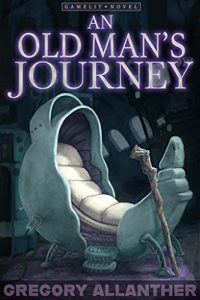 An Old Man’s Journey by Gregory Allanther:
An Old Man’s Journey by Gregory Allanther:
At the end of his life, Charles was left with one question: What was it all for?
After his tour of duty and an unremarkable post-Army business career, Charles spent his twilight years watching old movies and waiting for his grandkids to call. He’d lived a good life, been a decent man, but now that his wife was gone he was… Lonely.
Until his old friend Bert introduced him to Crossroads, the new VR sensation. In this virtual world he can move without pain, explore new lands, and most importantly – see his family again. For as long as he can hold their interest, in this fast-paced modern world of instant gratification and VR thrills.
The solution: Build a place his family wants to visit. Armed only with a magic stick with game-breaking powers that should be nerfed, Charles sets out on a journey to find a place to call his own. Along the way, he will be mistaken for an NPC quest giver, become the antagonist in epic questlines, and attempt to teach the next generation proper behavior – even if he has to beat it into them.
This is the story of one man’s search for belonging in his second virtual life. A search for a place to belong, and what it takes to get there. It’s also a hilarious romp through online fantasy cliches that will appeal to fans of Ready Player One, The Wandering Inn, and slice-of-life comedies.
Because at the end of a man’s life: What’s more important than family?
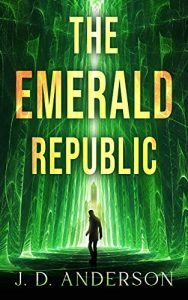 The Emerald Republic by J.D. Anderson:
The Emerald Republic by J.D. Anderson:
When a teen from Kansas is chosen as the king in a world filled with fantastic cities and extraordinary creatures, some of his ideas don’t go over well. Now he faces a divided Emerald City, a rebellion and the threat of a new Witch – and he’s doing everything he can to fight back.
As the situation in Oz grows desperate, Roy’s friends and family face a dire situation of their own: booze, lies, and an emerging war in 1930’s Europe, in the world Roy left behind.
Join Roy and the talking trees and hotheaded munchkins of Oz on a hilarious and thrilling quest to return the Emerald City to its former glory, by any means necessary…
The last word my mother ever said to me was, “Go.”
That was after I’d escaped the initial outbreak at my school. After I managed to find my mother and make my way home. After I thought I was safe.
But when my mother is bitten by a zombie, and I am forced to flee into the apocalyptic wasteland of South Texas, I find that survival means more than just being able to be strong. It’s about building bridges. Making connections. Finding friends. But will those friends help me save my life?
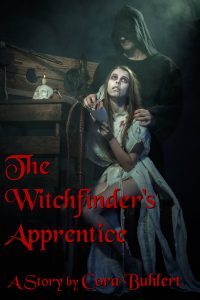 The Witchfinder’s Apprentice by Cora Buhlert:
The Witchfinder’s Apprentice by Cora Buhlert:
Massachusetts in the Year of the Lord 1695: Matthew Goodson, eighteen years of age, is apprenticed to a team of experienced witchfinders, who travel from village to village and town to town to uncover witchcraft, examine the evidence, interrogate suspects and stamp out evil.
When a wave of mysterious illnesses and deaths hits the town of Redemption, the witchfinders are called in and quickly arrest a suspect, a teenaged girl named Grace Pankhurst.
Matthew has long been having his doubts about the witchfinders and the righteousness of their mission. The interrogation of Grace brings those doubts to a flashpoint. But is Grace truly innocent or has Matthew fallen under the spell of a comely witch?
This is a historical horror story of 5500 words or approximately 20 print pages by two-time Hugo finalist Cora Buhlert.
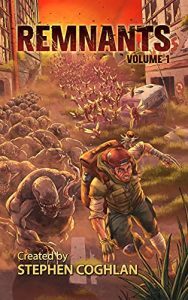 Remnants, edited by Stephen Coghlan:
Remnants, edited by Stephen Coghlan:
Strange clouds on the horizon herald the coming of the swarm. The undulating masses of the horde cannot be stopped. Terrifying creatures roam the Earth, seemingly with no aim but to devour all that stands before them. Experience the end of the world as we know it with these seventeen tales of horror, survival, and hope. The world ends in a frenzy of death and miasma of terror, but what will become of the remnants of humanity?
Seventeen tales of post-apocalyptic survival horror!
A team of military special operators. A lost race of advanced beings. An invading swarm of land-hungry sentient robots.
An elite team of SAS special operators battle across the multiverse after a plague of land-hungry sentient robots invade today’s Earth. But, when an aircraft carrier-based counterattack goes horribly wrong, it traps the team in an alien universe with a top-secret group who’ve already saved the world twice. After discovering a dark plot that threatens humanity’s very existence, the two groups jump into action, fighting both on the surface and in orbit in a last-ditch effort to stop the enemy before time runs out.
With the fate of two Earths hanging in the balance, the combined teams must pull a lost race of advanced beings off history’s scrapheap, or humanity will join them in oblivion.
Magnitude combines sleek starships, strange aliens, and high-tech weaponry to pit heroes, zeroes, and a smart-assed battlebot against powerful enemies
Maggie’s a now an auntie and ready to show this new nugget all the awesomeness of being a World Walker. But when the child is kidnapped as part of an ancient prophecy, Maggie and Killian must save the kid before nap time means a permanent sleep. The creatures of the Other Side are about to get a hands-on lesson in why you don’t mess with the MacKay girls.
A storm is coming. There is no escape…
It is a time of discovery, as our heroes venture forth on expeditions.
General Theodore Davies rushes to meet an ally, but will it be for naught? Olympus is but a shell, ready to be crushed under the heel of Rosae Crucis. The enemy is at the gates.
John Miller leads a team in search of answers. He knows the coordinates of his goal but doesn’t know if they will make it to their destination and back, or what they will even find.
New characters step out of the shadow and into the light. Their stories are told, and revelations made. What are the things that link them together? A mosaic is slowly being laid; Tile by tile.
In the meantime, the undead continue their mission. They snuff out all life that they find. They heed the call of the collective. They mass together, forming a tide that will wash over the living.
Now they come.
Follow along as events unfold in Itinerant, the third volume in Apocalypsis Immortuos
A world filled with magic, wizards and, enchanted beings—or the ashes of a highly advanced civilization?
The truth is much more complicated.
Zairoc, a dark wizard
Sir Francis, a benevolent wizard
Trick Mark, captain of the guard
and the construction robot CD-45.
Their destinies will collide at the city of Bastion. But concealed from everyone, a young woman holds the key to each of their fates.
Ondreeal has lived her whole life on the farm with her callous adoptive father. She longs to see the world and witness for herself the magical wonders that fill it—and she’ll soon get her wish, thrust into an adventure that carries her to heights she never dreamed possible, and to the depths of despair and loneliness. Ondreeal can never become the hero the world wants her to be.
But will she become the hero it needs?
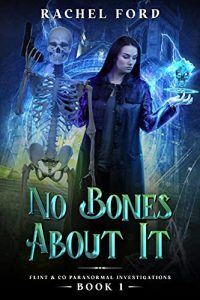 No Bones About It by Rachel Ford:
No Bones About It by Rachel Ford:
He’s a skeleton who used to be a cop. I’m a Freak who used to be a detective. Together, we’re going to find the woman I love.
Technically, the PD hasn’t fired me yet. But when my girlfriend, the star witness in the biggest embezzlement case in a century, went missing, I stepped on some toes. And maybe busted a senior detective’s nose.
He had it coming. He’s hiding something. I’m going to find out what, and I’m going to find my fiancée. But I can’t do it alone.
In a world of magic and undead beings, Normies avoid Freaks like me like the plague. Our magic terrifies them.
But there’s one place I know I can turn to find the help I need: the undead. So here I am, trusting the fate of my career and the love of my life to the bony hands of a 150 year old undead investigator.
And that’s a recipe for disaster. No bones about it.
A mysterious newcomer. Strange new infatuations. A cursed treasure.
A beautiful stranger arrives in Little Eerie asking questions about an ancient treasure. The jarl is smitten at first sight. He’s sick with love for her.
But when she doesn’t even recognize him the next day, Apprentice Wizard Idun Wintermoon knows there’s some kind of sorcery at play.
As more people succumb to the love sickness, Idun and the sellsword Liss Forlatt are in a race against time to find the culprit – and discover what her real motives are. Before she unleashes a curse on the jarldom that’ll make love sickness seem like a minor inconvenience.
 The Ghoul, the Bad and the Ugly by Lily Harper Hart:
The Ghoul, the Bad and the Ugly by Lily Harper Hart:
Zombies in Casper Creek? Say it ain’t so. Unfortunately, it looks to be true … and Hannah Hickok and her motley crew of helpers have a mess on their hands.
As Cooper Wyatt struggles with the perfect way to propose, his girlfriend is buried in zombie lore … and seemingly having a good time digging up solutions.
The bodies are rising from two different cemeteries, one so old it hasn’t seen a new resident in thirty years. Why, though?
Needing help, Lindy suggests her brother David join the team. He’s a paranormal investigator, and he has an interesting set of skills. He also seems to be sparking with animal wrangler Tyler James, which has all the women in a tizzy in an effort to help him make the ultimate connection.
Love is in the air. Zombies are on the streets. Trouble is afoot.
It’s a normal day in Casper Creek, but the stakes are ratcheting up. Hannah’s magic is off the charts, but this time the monsters she’s facing are like nothing she’s ever seen.
Death may be stalking Hannah but she’s not afraid to stand her ground. Survival isn’t a given, but if she makes it through to the end, Cooper has a surprise for both of them.
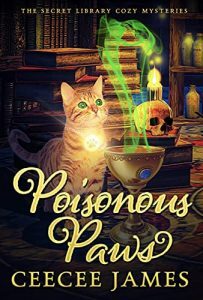 Poisonous Paws by CeeCee James:
Poisonous Paws by CeeCee James:
Murder can reach out and touch you when you least expect it.
The mysterious death of a town founder rocks the Thornberry Estate. Miss Janice is the main suspect and everyone is up at arms. How was she to know the truce she formed with her neighbor put the target squarely on her? Coupled with a strange box that shows up out of nowhere and filled with bizarre things beyond imagination, and strange footsteps at night has everyone anxious.
…then there’s the bit of the skeleton in the closet. Literally.
The book club group is determined to discover who the real culprit is, and who is sending them disturbing messages. Especially since no one is supposed to know the club exists.
Little do they know, that’s only the beginning of their problems.
If you like cozy mysteries with all the feels, good friendships, giggles and snorts, you’ll love this heartwarming series.
 Emanations: When a Planet Was a Planet, edited by Carter Kaplan:
Emanations: When a Planet Was a Planet, edited by Carter Kaplan:
The ninth volume of the critically acclaimed Emanations literary anthology series, Emanations: When a Planet was a Planet presents stunning new art, illustrations and writing from around the world. The forty-two contributors represent South Korea, Canada, India, Oman, France, Nigeria, England, Scotland, Northern Ireland, Germany, Spain, the Philippines, Sweden, Japan and the United States. Comprising a broad range of graphic and literary expressions, this new volume wonderfully sustains International Authors’ commitment to innovation and experimentation, with unusual visual pieces, intriguing artists’ statements, idiosyncratic memoirs, dynamic poetical constructions and cutting-edge speculative fiction.
Published by International Authors.
Far from the fury of The Great War, the citizens of the Liberty Federation live in peace and prosperity.
The Dawn Empire’s light is fading. Admiral Ikson Koto has one chance to renew the flame before it is extinguished forever. To save the Empire from a slow death, he must destroy the Federation’s fleet in one fell swoop. His plan calls for a brutality that has never been seen before.
For Lieutenant Shannon Reeve, the horrors of battle still burn strong in her mind. Her posting to a fighter squadron in the paradise of the Federation’s premier base, Azure Anchorage, should be a welcome respite. Instead, she will witness her fears come true as it comes under a relentless assault by Koto’s overwhelming Imperial forces.
Deep in the expanse of space known as the Great Void, a place far from home, civilian engineer Winston Grant has been tasked with upgrading a lonely base’s defences. Soon, he will find himself holding the line in a desperate last stand against an armada.
Both will play their parts in these darkest of days.
The golden age of the Federation will soon end, and instead be engulfed in the raging fire of war as Koto’s grand plan comes to fruition.
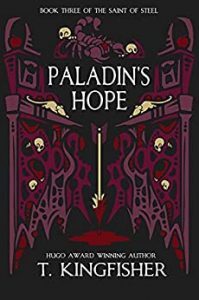 Paladin’s Hope by T. Kingfisher:
Paladin’s Hope by T. Kingfisher:
Piper is a lich-doctor, a physician who works among the dead, determining causes of death for the city guard’s investigations. It’s a peaceful, if solitary profession…until the day when he’s called to the river to examine the latest in a series of mysterious bodies, mangled by some unknown force.
Galen is a paladin of a dead god, lost to holiness and no longer entirely sane. He has long since given up on any hope of love. But when the two men and a brave gnole constable are drawn into the maze of the mysterious killer, it’s Galen’s job to protect Piper from the traps that await them.
He’s just not sure if he can protect Piper from the most dangerous threat of all…
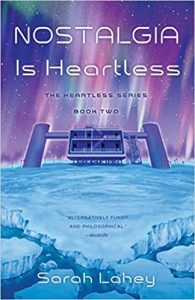 Nostalgia is Heartless by Sarah Lahey:
Nostalgia is Heartless by Sarah Lahey:
Earth, 2050. Pregnant, unemployed, and living back home with her father, climate scientist Quinn Buyers wonders how she got to this point in her life. Her famous scientist mother is mysteriously missing, the planet is at risk from a massive solar storm, the Transhumans want to take a colony to Titan, and her assisted living companion, a robotic meerkat, is showing clear signs of anxiety and depression. But her biggest challenge is her partner. How can she reconcile her long-distance relationship with this reserved, enigmatic cyborg?
The sequel to Sarah Lahey’s debut novel and the second book in the Heartless Series, Nostalgia is Heartless delves into the world of near future, exploring a society on the brink of climate catastrophe.
 Warlord of Ackbarr by Erme Lander:
Warlord of Ackbarr by Erme Lander:
“You can’t just invade, they’ll have men with crossbows looking out for you. They use poisoned arrows, they can fell your outriders in seconds.”
Cassai has managed the unthinkable by killing thousands and Ackbarr can no longer ignore the tiny country defying them. Mika must make a choice who she stands with – her adopted country or the homeland who expelled her as an animal. In the meanwhile, her grip on the human world is sliding…
The Medici Chronicles follows Mika through nearly twenty years of her life as she disguises herself as a boy to survive, learns to become a Medici and struggles to find where she belongs.
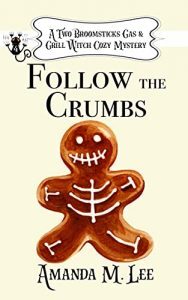 Follow the Crumbs by Amanda M. Lee:
Follow the Crumbs by Amanda M. Lee:
There’s a prominent threat on the block … and he might just be sharing Stormy Morgan’s roof.
She’s a new witch but she has a big problem … and it talks. Her new roommate Krankle may look cute but he’s a huge pain in her posterior. He’s also hiding something. Before she can focus on that, however, the unthinkable happens.
On the highway leading out of town, three vehicles are involved in an accident. One belongs to Harold Lautner, the former head of the senior center who went missing months before. He was presumed dead in a hunting accident, but now the truck he was driving at the time he fell off the face of the earth is front and center … and emergency crews say there’s nobody to save inside.
Hunter Ryan, Stormy’s boyfriend and a police officer in Shadow Hills, is chasing lead after lead but they’re going nowhere … and then things get worse.
A magical shadow, the type Stormy isn’t ready to fight, is taking over the town. The Winchester witches, who are eager to help, can’t offer much in the way of aid because their magic is being affected by the shadow. That leaves Stormy to solve things, and she has no idea how to do it.
Stormy is eager to learn but the curve is steep. Alone, she knows she will fail. That means her new friends have to pitch in and help … including Krankle.
Someone is lying. Someone is playing games. The answer to the question might be closer than it seems.
Stormy has a fight on her hands. Will she survive long enough to answer all the questions, or is she doomed to disappointment … and death?
One starship, six friends, 10,000 lives in the balance
Young captain-for-hire Kitra Yilmaz has gotten her first contract: escort the mysterious Princess of Atlántida beyond the Frontier and find her a new world. It’s a risky job, fraught with the threat of pirates, dangerous squatters, and rising romantic tensions.
Still, Kitra and her crew are up for anything — until they find a lush world, perfect for settlement…with an enormous ghost ship already in orbit.
What secret does the crippled vessel hide? And is Kitra ready to take responsibility for its precious cargo?
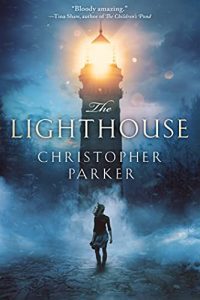 The Lighthouse by Christopher Parker:
The Lighthouse by Christopher Parker:
Enchanting, mysterious, and deeply romantic, The Lighthouse follows a young woman’s breathtaking journey far from home to discover where she truly belongs.
Something strange is happening in Seabrook. The town’s lighthouse–dormant for over thirty years and famously haunted–has inexplicably started shining, and its mysterious glow is sparking feverish gossip throughout the spooked community.
Amy Tucker is only visiting for the night and has no plans to get caught up in the hysteria, but that changes when she meets Ryan, the loyal, hard-working son of a ranch owner who lives on the outskirts of town.
Their chance encounter turns into an unforgettable weekend, and against the backdrop of the lighthouse-obsessed town, the two of them forge a deep connection, opening their hearts, baring their souls, and revealing secrets long kept hidden.
But as they grow closer, and as the lighthouse glows ever brighter, a startling discovery about Ryan leaves Amy questioning everything she thought she knew. To uncover the truth about her new friend, Amy will need to enter Seabrook’s ominous tower, where waiting inside she will not only find the reason why fate has brought them together… but a shocking secret that will change the course of their lives forever.
 The Last Days of Hong Kong by G.D. Penman:
The Last Days of Hong Kong by G.D. Penman:
Book 3 in the Witch of Empire series
In the aftermath of the war, Iona “Sully” Sullivan has lost everything; her job, her friends, her fiancé and even her magic. But when an old friend shows up on her doorstep, offering her the chance to undo one of her long litany of mistakes, there is still enough of the old Sully left to get her on the first boat to Hong Kong. A stranger in a strange land, Sully must navigate alien customs, werebear chefs, the blossoming criminal underworld, religious extremists, Mongol agents, vampire separatists, and every other freak, maniac or cosmic leftover with an iota of power as they all compete for a chance at the most valuable prize in all the world; a little sailor doll named Eugene, and the last wish on earth.
The Republic’s AI controls a clone on one planet. The League controls a bot on another . . .
Jade Thrall is the League’s Tetrarch but she holds a secret even she does not realize. She is a highly advanced droid, formerly known as Miriam.
Few military assets are available to Jade in her effort to wrest back League planets lost during the war. But one potent tool remains in her arsenal: assassins . . .
Join this rip-roaring, action-packed space opera adventure! Featuring space marines, rotten villains, fist fights, gun battles and sharp political intrigue, Digital Death kicks off a brand new series by veteran science fiction and fantasy author Jaxon Reed set in the Milky Way Universe.
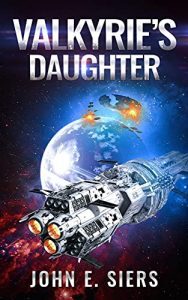 Valkyrie’s Daughter by John E. Siers:
Valkyrie’s Daughter by John E. Siers:
The Otuka are hunting a most dangerous game!
The alien Akara have a secret. They’ve discovered the location of a planet that is home to a primitive human civilization, another ancient “seeding” of the legendary Progenitors. But this planet lies in the territory of the Otuka, spacefaring alien predators who consider human flesh to be a delicacy and the planet to be their private hunting preserve.
Unwilling to confront the Otuka, the Akara have passed the problem to their human allies, the Lunar Free State. Now, the LFS needs to decide what to do about it. Are the “Moonies” willing to take responsibility for an entire planet’s population?
One thing seems certain: a favorite food of the Otuka is about to get much more expensive, as the LFS Marines stand ready to teach the Otuka hunters a hard lesson in the perils of hunting the humans in this part of the galaxy. But no one knows the technology state of the Okuta. Will the Marines be the hunters, or find themselves being hunted in turn?
A Bloody Revolution. Hard Choices. Fatal Consequences.
Sophie Arundel is stranded in a parallel universe, stuck in a grand house in an alternate 1925 England. Thankfully, she has her faithful dog, Charlotte. Oh, and Hugo Harrington who is stranded too — and Sophie’s fallen for him, head over heels.
Hugo’s entirely uninterested, but Sophie has bigger problems.
As a revolution threatens the Manor and everyone in it, Sophie finds the hidden portal to the twenty-first century. When she opens it, one man’s deadly secret will be exposed.
And he’ll kill to stop her.
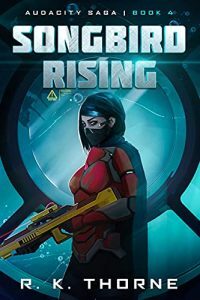 Songbird Rising by R.K. Thorne:
Songbird Rising by R.K. Thorne:
Commander Ellen Ryu, Lieutenant Kael Sidassian, and the crew of the starship Audacity have met every challenge thrown their way, from super soldiers, to telepaths, to rivals with axes to grind.
Each step has brought them closer to Ellen’s ultimate goal—finding and defeating Dr. Arakovic, the scientist who destroyed her unit, her brothers- and sisters-in-arms, and her promising Union career. The woman who nearly stole Ellen’s sanity.
But Arakovic’s Songbirds grow more powerful each day. The clues are adding up. And the Audacity crew is discovering that Songbird’s influence reaches deeper and farther than they ever expected.
They’ll dive into battle—but this time they may find themselves underwater.
Not every battle can be won. Ellen Ryu has never let that stop her from trying.
But with his newfound daughter and new friends to protect, will the cost be too high for Kael to stay by her side?
Jump into this epic adventure in a galaxy where abuse of science is rampant and hope is all some people have left. Character-driven space opera with a mix of humor, action, and romance, SONGBIRD RISING is the fourth book in the Audacity Saga.
October 29, 2021
Indie Crime Fiction of the Month for October 2021

Welcome to the latest edition of “Indie Crime Fiction of the Month”.
So what is “Indie Crime Fiction of the Month”? It’s a round-up of crime fiction by indie authors newly published this month, though some September books I missed the last time around snuck in as well. The books are arranged in alphabetical order by author. So far, most links only go to Amazon.com, though I may add other retailers for future editions.
Our new releases cover the broad spectrum of crime fiction. We have cozy mysteries, holiday mysteries, humorous mysteries, historical mysteries, Jazz Age mysteries, paranormal mysteries, crime thrillers, action thrillers, historical thrillers, revenge thrillers, noir, romantic suspense, police officers, amateur sleuths, FBI agents, CIA agents, reporters, assassins, human traffickers, vigilantes, serial killers, severed heads, Puritan witch hunters, crime-busting witches, crime-busting socialites, crime-busting journalists, crime-busting skeletons, murder and mayhem in London, Galveston, Silicon Valley, Massachusetts, Hong Kong, Colombia, at a science fiction convention and much more.
Don’t forget that Indie Crime Fiction of the Month is also crossposted to the Indie Crime Scene, a group blog which features new release spotlights, guest posts, interviews and link round-ups regarding all things crime fiction several times per week.
As always, I know the authors at least vaguely, but I haven’t read all of the books, so Caveat emptor.
And now on to the books without further ado:
 The Witchfinder’s Apprentice by Cora Buhlert:
The Witchfinder’s Apprentice by Cora Buhlert:
Massachusetts in the Year of the Lord 1695: Matthew Goodson, eighteen years of age, is apprenticed to a team of experienced witchfinders, who travel from village to village and town to town to uncover witchcraft, examine the evidence, interrogate suspects and stamp out evil.
When a wave of mysterious illnesses and deaths hits the town of Redemption, the witchfinders are called in and quickly arrest a suspect, a teenaged girl named Grace Pankhurst.
Matthew has long been having his doubts about the witchfinders and the righteousness of their mission. The interrogation of Grace brings those doubts to a flashpoint. But is Grace truly innocent or has Matthew fallen under the spell of a comely witch?
This is a historical suspense story of 5500 words or approximately 20 print pages by two-time Hugo finalist Cora Buhlert.
 Murder on a Girl’s Night Out by Beth Byers:
Murder on a Girl’s Night Out by Beth Byers:
Vi is one of those women lucky enough to have good friends. In fact, Kate, Rita, and Lila are closer to Vi than her own sister. With children arriving and what feels like an endless cycle of trouble, their friendship has been pushed to it’s limit. It’s long past time to get together–just the girls.
Is it even surprising when things go sideways? Or when they find themselves looking over their shoulders? Or when they find, one again, that they’re stronger together?
The billionaire predators of Silicon Valley always get what they want.
Now someone is giving them what they deserve.
Journalist Lou McCarthy has spent her career exposing powerful predators in Silicon Valley. Her crusade has cost her everything: Her apartment, friends, relationships, and any hope of promotion. And for what? Readers don’t care, her boss and workmates pity her, and the billionaire bro-ciopaths she writes about continue to fail upwards.
But when two of her highest profile subjects are killed on the same night, their deaths staged as gruesome public suicides, Lou’s work is suddenly and violently thrust into the spotlight. Blamed for the deaths, fired from her job, and pursued by vengeful trolls who have already attacked her mother, Lou has only one chance of survival: To find the killer obsessed with her work, and stop them before anyone else dies.
Or perhaps not. Because the more Lou discovers about the ingenious killer’s past, and their methods, the more she becomes determined to help them succeed.
THE MURDERS BEGIN SUDDENLY…
BUT THE SECRET HAS BEEN KEPT FOR YEARS.
Vigilante assassin Silence Jones is accustomed to hunting people who escaped justice. But nothing can prepare him for the depths of deceit he’s about to face.
People are being murdered across the United States, and law enforcement is powerless to stop it. The victims’ only connection: they’re all survivors of a military training disaster years earlier.
As Silence feverishly chases the killer around the country, he uncovers a sinister coverup and the dark forces willing to do anything to maintain the secret. If Silence is going to stop the slaughter, he’ll have to tear down a web of lies that powerful people have held in place for years.
The next standalone action thriller in the pulse-pounding new series. Enter the world of Silence Jones. Hold on tight…
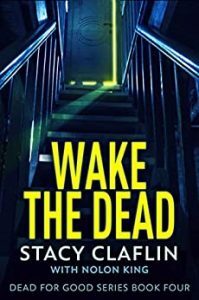 Wake the Dead by Stacy Claflin and Nolon King:
Wake the Dead by Stacy Claflin and Nolon King:
There’s no cross like a double-cross. Except maybe a double-double-cross.
Assassin Brad Morris has finally been arrested for murder, but not for a murder he actually committed. Now he’s cooling his heels in jail — his lawyer seems to have forgotten him, and his boss might have betrayed him.
Just as he’s starting to lose hope, he gets a visit from the CIA. Agent June Bancroft has an offer for Brad: full immunity, if he’s willing to spy on his boss and fellow assassins for her. Worse, Bancroft wants his daughter Hadley’s help, too.
Brad agrees, but soon finds out how hard it is to answer to two bosses while pursuing an agenda of his own.
Can Brad keep his family safe while operating as both a CIA asset and an assassin? Or will his double life destroy everyone he loves?
 No Bones About It by Rachel Ford:
No Bones About It by Rachel Ford:
He’s a skeleton who used to be a cop. I’m a Freak who used to be a detective. Together, we’re going to find the woman I love.
Technically, the PD hasn’t fired me yet. But when my girlfriend, the star witness in the biggest embezzlement case in a century, went missing, I stepped on some toes. And maybe busted a senior detective’s nose.
He had it coming. He’s hiding something. I’m going to find out what, and I’m going to find my fiancée. But I can’t do it alone.
In a world of magic and undead beings, Normies avoid Freaks like me like the plague. Our magic terrifies them.
But there’s one place I know I can turn to find the help I need: the undead. So here I am, trusting the fate of my career and the love of my life to the bony hands of a 150 year old undead investigator.
And that’s a recipe for disaster. No bones about it.
 The Ghoul, the Bad and the Ugly by Lily Harper Hart:
The Ghoul, the Bad and the Ugly by Lily Harper Hart:
Zombies in Casper Creek? Say it ain’t so. Unfortunately, it looks to be true … and Hannah Hickok and her motley crew of helpers have a mess on their hands.
As Cooper Wyatt struggles with the perfect way to propose, his girlfriend is buried in zombie lore … and seemingly having a good time digging up solutions.
The bodies are rising from two different cemeteries, one so old it hasn’t seen a new resident in thirty years. Why, though?
Needing help, Lindy suggests her brother David join the team. He’s a paranormal investigator, and he has an interesting set of skills. He also seems to be sparking with animal wrangler Tyler James, which has all the women in a tizzy in an effort to help him make the ultimate connection.
Love is in the air. Zombies are on the streets. Trouble is afoot.
It’s a normal day in Casper Creek, but the stakes are ratcheting up. Hannah’s magic is off the charts, but this time the monsters she’s facing are like nothing she’s ever seen.
Death may be stalking Hannah but she’s not afraid to stand her ground. Survival isn’t a given, but if she makes it through to the end, Cooper has a surprise for both of them.
 Poisonous Paws by CeeCee James:
Poisonous Paws by CeeCee James:
Murder can reach out and touch you when you least expect it.
The mysterious death of a town founder rocks the Thornberry Estate. Miss Janice is the main suspect and everyone is up at arms. How was she to know the truce she formed with her neighbor put the target squarely on her? Coupled with a strange box that shows up out of nowhere and filled with bizarre things beyond imagination, and strange footsteps at night has everyone anxious.
…then there’s the bit of the skeleton in the closet. Literally.
The book club group is determined to discover who the real culprit is, and who is sending them disturbing messages. Especially since no one is supposed to know the club exists.
Little do they know, that’s only the beginning of their problems.
If you like cozy mysteries with all the feels, good friendships, giggles and snorts, you’ll love this heartwarming series.
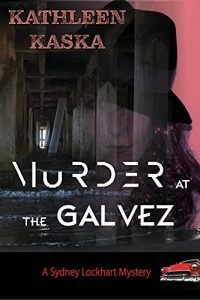 Murder at the Galvez by Kathleen Kaska:
Murder at the Galvez by Kathleen Kaska:
Eighteen years after discovering the murdered body of her grandfather in the foyer of the historic Galvez Hotel, reporter Sydney Lockhart returns to Galveston, Texas to cover a story. Instead, she finds herself embroiled in a murder mystery.
Something fishy is going on in Galveston, Texas, and Sydney is smack dab in the middle of it when she checks into the historic Galvez Hotel, a place that stirs her most uncomfortable memories. She’s there to cover the controversial Pelican Island Development Project conference, but soon after her arrival, the conference is canceled, the keynote speaker is missing, and a body turns up in the truck of Sydney’s car. Next, Sydney’s hauled to the police station for questioning.
As if this wasn’t bad enough, just a few blocks from the hotel at her parents’ home, people are gathering, sparks are flying, another controversial event is in the planning, one that just might rival the Great Storm of 1900.
Sydney is helped and obstructed by her cousins, Ruth and Marcela, and Dixon, her beloved partner-in-solving-crime. But ultimately it’s up to Sydney, armed with wit and bravado (and Dixon’s .45), who must discover who killed the man in the trunk and why her father’s new friend is floating face-down in a fish tank with a bullet in his head. Her father’s odd behavior and the anonymous threatening notes delivered to her hotel room lead Sydney to suspect that her grandfather’s unsolved murder and the present murders might be connected.
 Follow the Crumbs by Amanda M. Lee:
Follow the Crumbs by Amanda M. Lee:
There’s a prominent threat on the block … and he might just be sharing Stormy Morgan’s roof.
She’s a new witch but she has a big problem … and it talks. Her new roommate Krankle may look cute but he’s a huge pain in her posterior. He’s also hiding something. Before she can focus on that, however, the unthinkable happens.
On the highway leading out of town, three vehicles are involved in an accident. One belongs to Harold Lautner, the former head of the senior center who went missing months before. He was presumed dead in a hunting accident, but now the truck he was driving at the time he fell off the face of the earth is front and center … and emergency crews say there’s nobody to save inside.
Hunter Ryan, Stormy’s boyfriend and a police officer in Shadow Hills, is chasing lead after lead but they’re going nowhere … and then things get worse.
A magical shadow, the type Stormy isn’t ready to fight, is taking over the town. The Winchester witches, who are eager to help, can’t offer much in the way of aid because their magic is being affected by the shadow. That leaves Stormy to solve things, and she has no idea how to do it.
Stormy is eager to learn but the curve is steep. Alone, she knows she will fail. That means her new friends have to pitch in and help … including Krankle.
Someone is lying. Someone is playing games. The answer to the question might be closer than it seems.
Stormy has a fight on her hands. Will she survive long enough to answer all the questions, or is she doomed to disappointment … and death?
 The Last Days of Hong Kong by G.D. Penman:
The Last Days of Hong Kong by G.D. Penman:
Book 3 in the Witch of Empire series
In the aftermath of the war, Iona “Sully” Sullivan has lost everything; her job, her friends, her fiancé and even her magic. But when an old friend shows up on her doorstep, offering her the chance to undo one of her long litany of mistakes, there is still enough of the old Sully left to get her on the first boat to Hong Kong. A stranger in a strange land, Sully must navigate alien customs, werebear chefs, the blossoming criminal underworld, religious extremists, Mongol agents, vampire separatists, and every other freak, maniac or cosmic leftover with an iota of power as they all compete for a chance at the most valuable prize in all the world; a little sailor doll named Eugene, and the last wish on earth.
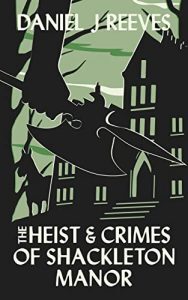 The Heist and Crimes of Shackleton Manor by Daniel J. Reeves:
The Heist and Crimes of Shackleton Manor by Daniel J. Reeves:
Sitting fully clothed in his tepid shower and busily dwelling on his romantic misfortune, Seamus is not ready for much of anything. Above all, he is certainly not ready to find the severed, bloody head of an old industry magnate stuffed inside of his university backpack. Seamus has his vices, but a severed head enthusiast he is not.
Chuck, a new acquaintance of his, reacts with perplexing enthusiasm to this turn of events, and together they plunge into a twenty-five year old mystery of love and betrayal at the decadent Shackleton Manor. Will Seamus solve the crime, accidentally implicate himself in it, or simply drink himself to sleep whilst hiding in the basement?
 Oy Vey, Maria! by Mark Reutlinger:
Oy Vey, Maria! by Mark Reutlinger:
Rose Kaplan and her sidekick Ida are at it again. It’s the holiday of Purim, and almost everyone at the Julius and Rebecca Cohen Home for Jewish Seniors is in costume for the Purim play. All except one, who will instead have to be fitted for a shroud. Once again, “Mrs. K” and Ida are called upon to solve the puzzle of a mysterious death at the Home. Described by Chanticleer Book Reviews as “at times more Lucy and Ethel than Holmes and Watson, with a soupcon of Miss Jane Marple,” these geriatric amateur sleuths will keep you laughing, guessing, and maybe even learning a bissel Yiddish!
What do we do when the truth hurts too much?
Fresh out of the national academy – mother of two – FBI profiler Eva Rae Thomas is in over her head on her first assignment in multi-million-copy bestselling author Willow Rose’s breath-taking mystery.
When the mother of two, Arlene Wood, crashes her car against a tree at four in the morning, the case seems pretty straightforward.
But evidence found in the remains of the car soon raises the question of whether this was really an accident.
Shortly after, her husband is taken in and later convicted of having murdered his wife.
But many questions remain unanswered.
Why was Arlene driving in the middle of the night?
Why did she leave the house, her husband, and her sleeping children, get into her car, and drive away?
Was she meeting someone?
A friend?
A lover?
A killer?
Six years later, Special Agent Eva Rae Thomas is new on the job when she stumbles upon something that suddenly blows this case wide open.
But can she persuade anyone to reopen the case even when the husband has admitted that he is guilty?
And will she be able to do it in time before this killer strikes again?
 My Emerald Jungle by Adler Stevens:
My Emerald Jungle by Adler Stevens:
Having my daughter, Haley, and her old high school sweetheart, Steve, kidnapped is the right thing to do. If anybody deserves a second chance at romance, it’s those two. And there’s nothing like a frightening adventure to bring two people together.
But something terrible has happened. Haley and Steve never arrived on the secluded island near Puerto Rico. Instead, they’re somewhere in Colombia, in the jungle, being held by human traffickers.
I’m afraid for the safety of my lovely little girl, but I know Haley is in Steve’s very strong and capable hands.
Or is it the other way around?
It’s a messy, bloody, crime. It’s a proper crime.
A pimp and drug dealer is found tortured and shot. That makes for a messy scene, but not a striking crime. Discovering that someone is trying to make it seem that the prostitute who tortured him also killed him — that grabs Sherry Proper’s attention, makes it a proper crime.
Anytime a crime is textured, layered, and fascinating, it provides glimpses into the dark underbelly where people from all social strata, as well as their money, ambition, and greed can intersect. Sherry calls these Proper Crimes.
It’s a passion. A passion with only dark sides, and one that can take her up to her neck in danger and trouble in a heartbeat.
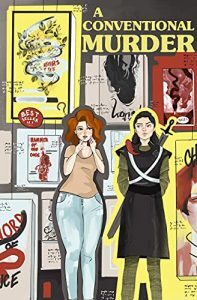 A Conventional Murder by Nathaniel Webb:
A Conventional Murder by Nathaniel Webb:
It’s a Daylight Savings Crime!
Kit Morrison just wants to enjoy her hometown sci-fi convention, but things keep getting in the way: con drama, annoying fans, murder… Sci-fi/fantasy author Nathaniel Webb takes on the cozy in his mystery debut, featuring a hilarious amateur sleuth and a tricky, twisty mystery worthy of the classics.
Art teacher, single mom, and geek girl Kit Morrison hasn’t been to her hometown sci-fi con in a decade. All she wants is to sell some art and catch up with old friends. But when a legendary fantasy author is murdered, Kit’s detective brother makes her his nerd sherpa. Kit’s happy to guide him through the weird world of con life—until he makes her favorite student his prime suspect. And then there are the threatening notes that keep appearing in her hotel room…
Kit will confront crazy fans, navigate major drama, wait for the elevator, learn about industrial laundry machines, and try her best to get a croissant—and with luck, prove her student’s innocence before the convention ends!
You’ll laugh—you’ll cheer—you’ll stay up late and fall asleep in a work meeting the next day. Come meet Kit, a sleuth like no other.
October 24, 2021
Fancast Spotlight: Light On Light Through
Even though I recently announced the new Semiprozine Spotlight series, I’m still featuring fanzines and fancasts, too.
And therefore, here is the next entry in the Fancast Spotlight project. For more about the Fanzine/Fancast Spotlight project, go here. You can also check out the other great fanzines and fancasts featured by clicking here.
Today, I’m pleased to feature Light On Light Through, a podcast run by Paul Levinson, who’s a science fiction author, singer/songwriter, media critic and professor of communications and media studies at Fordham University.
Paul Levinson is clearly a very busy man, so I’m thrilled to welcome him to my blog today to talk about Light On Light Through.
Tell us about your podcast or channel.
I posted the first episode of Light On Light Through on 21 October 2006, a little over 15 years ago to the day. The topics of the podcast are everything I find interesting or important, ranging from the cars I drive to the science fiction series I watch on television. The format is usually me talking. Sometimes I do interviews with editors, authors and actors, sometimes I post readings that I do of my science fiction stories and concerts of my music. I started the podcast doing as many as two or three episodes a week. As the years went by, I became so involved in other projects – finishing a novel, making a new recording – that the number of episodes of Light On Light Through were just three or four per year. But during the lockdown due to the pandemic, I was spending much more time at home, and by the Summer of 2020 I was back to doing as many as 4 or 5 episodes a month. The past few months, the early Fall of 2021, have brought such a cascade of great science fiction on the screen that I’m posting podcast reviews several times a week. In just the past few days, I’ve watched and reviewed a new episode of the Foundation series, the first half of the new Dune movie, and the debut of a new series, Invasion.
Who are the people behind your podcast or channel?
Just me. I do all the taking and recording and posting links to the episodes all over the known and unknown universe. That’s actually one of the things I really love about podcasting – I can do whatever I want with the podcast, whenever I want. Podcasting is a great way to satisfy your creative impulses.
Why did you decide to start your podcast or channel?
I love to talk. That’s one of the reasons I became a professor. But the advantage of podcasting is you can talk about whatever you want to talk about. My first episode in 2006 was about the joys of driving my new hybrid Prius. The second was a review of Battlestar Galactica. Then I had episodes that discussed why I like Trader Joe’s supermarkets and dislike Daylight Savings Time. By the way, I also love to write – that’s why I became an author. I review lots of science fiction on my blog. These often are written springboards for my podcast episodes.
What format do you use for your podcast or channel and why did you choose this format?
I upload MP3s of my episodes to Libsyn. I’ve been with them from the very beginning of my podcast in 2006. Yes, they do charge a monthly fee, but they have great statistics on number and places of downloads, and they have great distribution to social media and podcast apps all over the world.
The fan categories at the Hugos were there at the very beginning, but they are also the categories which consistently gets the lowest number of votes and nominations. So why do you think fanzines, fancasts and other fan projects are important?
Fanzines and other fan projects are vitally important because they are the voice of the people – literally so in the case of podcasts. Why, for example, should reviews of science fiction television series be only found in professional publications on the Internet, like Variety or The New York Times? The beauty and utility of podcasting is that anyone can express their opinion for the world to hear.
In the past twenty years, fanzines have increasingly moved online and fancasts have sprung up. What do you think the future of fan media looks like?
I think the future of fanzines and fancasts is very bright. Podcasts have been bursting out all over the past few years. Listeners love their convenience and specific focus on subjects of interest. I expect fan media to continue growing at an even faster pace.
The four fan categories of the Hugos (best fanzine, fan writer, fan artist and fancast) tend to get less attention than the fiction and dramatic presentation categories. Are there any awesome fanzines, fancasts, fan writers and fan artists you’d like to recommend?
Right now, I’m really focused on the Foundation series on Apple TV+ and the original Isaac Asimov stories and novels. My favorite fancast about the importance of the Foundation narrative, and its relevance to our world today, is Joel McKinnon’s Seldon Crisis podcast. My favorite fan writer review site is Cora Buhlert’s own blog, where she provides in-depth, spirited reviews of each episode, with a copy of Asimov’s novels close at hand.
Where can people find you?
Light On Light Through podcast: https://paullev.libsyn.com/
Paul Levinson’s Infinite Regress blog: https://paullevinson.blogspot.com/
YouTube channel: https://www.youtube.com/c/PaulLevinson
Amazon books: https://www.amazon.com/author/paullevinson
IMDb: https://www.imdb.me/paullevinson
Spotify: https://open.spotify.com/artist/5wWMm7Q8SSRTvvIJ1GLiRY?si=EguRjFf-QoK-L3La03ohOA
Twitter: https://twitter.com/PaulLev
Thank you, Paul, for stopping by and answering my questions.
Do check out Light On Light Through, cause it’s a great podcast.
***
Do you have a Hugo eligible fanzine/-site or fancast or a semiprozine and want it featured? Contact me or leave a comment.
October 23, 2021
Foundation encounters “Death and the Maiden”
Looks like I’m doing episode by episode reviews of Foundation – at least for now – so here is my take on episode 6. Reviews of previous episodes of Foundation as well as two actual Foundation stories may be found here.
For more Foundation discussion, check out the Star’s End and Seldon Crisis podcasts.
But before we get to this week’s episode of Foundation, I also want to point you to the other TV show of which I’m currently doing episode by episode reviews. Because my latest Raumpatrouille Orion (Space Patrol Orion) reviews are up at Galactic Journey. Here’s episode 2, “Planet Off Course” and episode 3 “Guardians of the Law”, which also happens to be an unofficial adaptation of an Isaac Asimov robot story.
Which brings us back to Foundation, one of the comparatively few official Asimov adaptations.
Warning: Spoilers behind the cut!
After an episode of absence, the Emperors Three are back and get two of the three plot strands of the episode devoted to them. The IMO least interesting of those three plots involves Brother Day’s and Demerzel’s trip to the planet of the generic triple goddess religion. Okay, so we do get to see Lee Pace wearing nothing but a towel (always a plus) and Demerzel finally changes her clothes and hairstyle, but otherwise this whole subplot not only has nothing to do with the books, it also fails to move the story forward in any way. Plus, it undermines Demerzel/Daneel’s character.
Now I have stated before that I have a very low tolerance for religious content, whether real world or fictional religions, in science fiction. And the Brother Day segment is basically all about the internal religious squabbles and schisms of the generic triple goddess religion a.k.a. Luminism. Now I can accept that Luminism is apparently one of the Empire’s major religions with three trillion worshippers. And the Maiden, Mother, Crone trichotomy of Luminism nicely mirrors of Dawn, Day, Dusk trichotomy of the Emperors Three. Nonetheless, I still don’t give a damn about these people and the details of their beliefs.
As was mentioned in episode 4, the leader/high priestess of Luminism has died. Because it’s such a popular religion, this is a big deal, similar to the death of a pope. Usually, there is a designated successor to this high priestess, but this time there are two potential candidate, a white woman who is friendly inclined towards the Empire, and a black women, who is an upstart and not friendly inclined towards the Empire at all. In fact, the black priestess believes that the Emperors Three are not really human, because their souls cannot be reincarnated, as the Luminist religion demands. And no, I can’t help but notice that here we have yet another antagonist who’s played by an actress of colour. This pattern is becoming really notable.
If theological debates involving real world religions make my eyes glaze over, theological debates of fictional religions are even worse. Because to be honest, I don’t give a damn if the Luminists believe that the Emperors Three share one soul or have none or fourteen souls. Personally, I’d say that clones or not, the Cleons are human and if you believe that humans have souls, then the Cleons must have one. But it honestly doesn’t matter to anybody except the Luminists. And since Luminism is a fictional religion, though inspired by several real world religions, that means that no one cares, because there are no Luminists.
Brother Day pretty much feels about the Luminists as I do. He doesn’t care what they believe and assumes that throwing money at the problem – by promising the Luminists to build a desalination plant to solve the lack of salt-free drinking water on the habitable moon that is the centre of their religion and location of their temple. This would seem to be a perfectly logical thing to do, since it solves a real world problem that these people have, namely a lack of clean water, rather than some spiritual mumbo jumbo about souls and reincarnation. However, religion is not logical and so the heretical rival priestess (T’Nia Miller) gives a rousing speech, denouncing the Emperors Three by claiming that they are not developing and evolving, because their souls are not reincarnated. And since she’s an excellent speaker, the Luminists are completely convinced and drop to their knees.
Personally, I was reminded of Fritz Leiber’s 1959 Fafhrd and Grey Mouser story “Lean Times in Lankhmar”, where Fafhrd finds religion and briefly brings the obscure cult of Issek with the Jug (not to be confused with Issek in the Jug or any other number of Isseks) to prominence due to being a trained skald and excellent storyteller. “Lean Times in Lankhmar” (which I encourage everybody to read, because it’s hilarious) was supposedly inspired by Fritz Leiber’s brief time as an Episcopal priest, where his acting experience made him an extremely popular preacher, even though the vocation was lacking. The heretical priestess is Fafhrd or Leiber in this episode. She’s simply a better speaker than her rival. Too bad she also has it in for the Emperors Three for reasons unknown – unless she really believes every word she’s saying, which is of course possible. After all, Fafhrd did take Issek seriously as well.
The problem with the whole “Brother Day and the religious schism” segment is not only that it is boring (though visually gorgeous), but also that – unlike “Lean Times in Lankhmar” – the show takes Luminism absolutely seriously, as if it were a real religion with real worshippers, even though it is no more real than Leiber’s cult of Issek with the Jug (not to be confused with Issek in the Jug or any other number of Isseks).
And then there is Demerzel, who is revealed not only to be an adherent of Luminism, but who also drops to her knees when the rival priestess holds her speech. Now Demerzel/Daneel does show an interest in religion in the books, since Daneel and Elijah Baley have several philosophical discussions about biblical matters in The Caves of Steel. However, there is never any indication that Daneel views the biblical stories he discusses with Elijah as anything other than interesting philosophical questions. After all, Elijah uses the biblical story of Jesus and the adulteress to illustrate that following the letter of the law does not equal justice. But then, the biblical discussions in The Caves of Steel draw on examples taken from an actual religion, with which many/most readers will be familiar. Besides, the whole episode is funny in a way that Foundation is not, because Daneel has no idea what adultery is or what stoning is for that matter and keeps asking Elijah to explain, who is very embarassed by the whole thing. Come to think of it, I would love to see Laura Birn as Daneel in the Elijah Bailey/R. Daneel Olivaw buddy cop show.
Besides, Demerzel believing in Luminism of all religions also makes little sense in this context, because if even the cloned Emperors Three don’t have a sould according to the black priestess, then Demerzel who is a robot most definitely doesn’t have a soul. Not that this is a problem for me, but it clearly is one for the Luminists. So why would anybody, least of all the most advanced robot in the galaxy, follow a religion that treats them as not only less than human but potentially evil? Never mind that Daneel/Demerzel is old enough that he/she was already around when the moon broke into three parts, which initiated the religion, and knows there is nothing divine about that. Honestly, this makes no sense. Though I did love the way that Demerzel lied to Brother Day’s face that her purpose is to serve the Emperors and the Empire, because we know that her purpose is much bigger than that.
Camestros Felapton enjoyed the “Brother Day and the theological debate” plotline rather more than I did, but then he has a higher tolerance for theological debates than I do. Besides, Camestros agrees that the whole Luminism subplot doesn’t move the overall plot forward by a single inch.
While Brother Day is away, dealing with annoying religions, Brother Dusk and Brother Dawn hold the fort in Trantor. Brother Dawn is still fascinated by the female gardener who chanced to witness his failed suicide attempt in episode 4 and seeks her out to thank her for her herbal pain relief tips.
Meanwhile, Brother Dusk has taken it upon himself to make Brother Dawn into a man – quite literally. So he first takes Brother Dawn hunting for what looks like little pterodactyls in the Emperors’ private hunting preserve. Personally, I was reminded of the accidental pterodactyl cameo in Citizen Kane. I love the blue hunting coats BTW, though they don’t look exactly practical.
The pterodactyl creatures are sneaky and blend into the foliage, so they are not easy to shoot. However, Brother Dawn turns out to be remarkably adept at shooting them, much more adept than Brother Dusk. And so Brother Dawn shoots seven pterodacytls on his first day out, whereas Brother Dusk never managed more than three in one day. However, Brother Dawn is terrified of Brother Dusk – just as the current Brother Day was terrified of him, when he was Brother Dawn – and so he instructs his attendant to throw four of the pterodactyl things away, so he will not break Brother Dusk’s record. However, one of Brother Dusk’s attendants finds the discarded pterodactyl corpses, so Brother Dawn’s secret is out.
After the hunt, the quest to make a man of Brother Dawn continues in the Imperial harem (yes, there is such a thing. I’m sure John W. Campbell and Kay Tarrant would be shocked and Asimov pleased). The Imperial harem contains young women (apparently, all Cleons are assumed to be straight) from all over the Empire, who will have their memories wiped after their time with the Emperors Three to avoid any tell-all memoirs. Meanwhile, Conan, who has a harem himself in his time as King of Aquilonia, wonders where the fun is, if the ladies forget what happened during their time spent with him.
Brother Dusk encourages Brother Dawn to pick a woman. Brother Dawn picks one who reminds him of the young gardener and takes her to his chambers, but won’t do anything with her. “I’ll tell them you did fine”, he tells her and remarks that since she’ll have her memories wiped, she won’t remember anything different either. However, the woman doesn’t have her memories wiped at once and tells Brother Dusk exactly what happened, namely nothing.
The next day, Brother Dawn has the young gardener called to his chambers (once he realises that he can do that) to show her what the garden looks like from above. The garden scenes were shot somewhere in Bavaria, which is why the logo of the German film support fund is in the credits. Brother Dawn entices the young gardener to step onto the ledge, from which he tried to jump back in episode 4. She’s reluctant at first, but Brother Dawn takes off his personal force field and offers it to her. The gardener refuses, so they both stand on the ledge in a very precarious position and without any protection. They admire the gardens and Brother Dawn asks the gardener to describe the colours to him, whereupon she realises that Brother Dawn is colour-blind. This is also why he is such a good hunter.
Now colour blindness is a genetic condition in the vast majority of cases and men are more affected than women. And therein lies the problem, because no other Cleon has ever been colour-blind, which suggests that the cloning process is imperfect and genetic mutations are creeping in.
Brother Dawn is terrified that someone will find out his secret, because he fears that as a defective clone, he will simply be killed and replaced by another clone. And considering that the first Brother Dusk we saw was disintegrated, this fear is not entirely unjustified. There is a tense moment with the gardener who knows his secret and could expose him to Brothers Dusk and Day, then Brother Dawn and the gardener kiss.
Paul Levinson notes in his review of this episode that in Forward the Foundation, Cleon I is murdered by a gardener in front of the eyes of Hari Seldon, though that gardener is an old man. The purpose of that scene (which I had completely forgotten) is to show that even Hari Seldon can’t predict the actions of individuals like a deranged gardener murdering the Emperor.
Meanwhile, in the TV show, the purpose of the various Emperors Three scene is to show the slow but inevitable decline of the Empire. The Brother Dawn sequences show that decline on a genetic level, since the cloning process seems to be breaking down from too many copies made, while the Brother Day sequences show the decline on a macro level.
I wasn’t too impressed by the teenaged version of Brother Dawn in episode 4, but I like his storyline in this episode. Meanwhile, as mentioned above, the whole Brother Day sequence is just dull. I understand that the showrunners want to show the decline and fall of the Empire on the screen rather than have it happen off-page as in the books. But honestly, couldn’t they have come up with something more interesting for Brother Day to do than deal with the internal squabbles of an annoying religion? I suspect that the religion angle is a reference to the rise of Christianity, which coincided with (and some feel was to blame for) the decline of the Roman Empire. But while visually very pretty, the whole Luminist sequence was just dull and made me yell at the screen, “Oh, just have the rabble-rousing priestess assassinated and pass it off as the will of the goddess.”
Which brings us to the main storyline – even if the show keeps forgetting it – on Terminus, where the Anacreons have broken through the fence around Terminus City and are happily murdering Foundationers in the streets, while Salvor Hardin has been taken prisoner by Supreme Huntress Nutcase Phara and her little gang of Xena cosplayers. The Anacreons also managed to shootdown an Imperial warship under the command of Lord Dorwin. Though amazingly, Dorwin survives the fiery crash – being married to the Thirteenth Doctor has its advantages – only to be promptly taken prisoner by the Anacreons.
Phara is uncommonly interested in certain Foundationers who had vital roles in piloting the starship that brought the Foundation to Terminus. She’s also keeping Dorwin alive, because she needs him. It becomes clear that Phara needs people who can operate a jumpship. And not just any old jumpship either, but the Invictus, a legendary lost Imperial superweapon. Uh-oh.
Quite a few people such as io9 reviewer Rob Bricken were annoyed at the whole Invictus angle, because Isaac Asimov’s original stories barely have space battles, let alone Death Star type superweapons. However, the whole Invictus bit is actually closer to the original stories than the whole Luminism stuff. Because an abandoned Imperial battlecruiser retrofitted by the Foundation on behalf of Anacreon does play a role in “Bridle and Saddle”, the second of the original Foundation stories, which was published in the June 1942 issue of Astounding and later became chapter three of the first book under the title “The Mayors”. Coincidentally, there’s also a character named “Fara” in that story, though that character is a) male and b) a Foundationer, not someone from Anacreon. Can you tell that I have my copy of Foundation next to the computer to look this stuff up?
The battlecruiser in “Bridle and Saddle” is called Wienis, after the treacherous Prince Regent of Anacreon, and not Invictus. But whatever the name, both are Imperial battleships retrofitted and refurbished by the Foundation with their superior technology on behalf of Anacreon. In “Briddle and Saddle”, the villainous Prince Regent Wienis wants to use the eponymous battlecruiser to launch an attack against Terminus. However, the Foundation has built in a fail-safe in the form of a kill switch, which is then remotely triggered after a priest of the Foundation’s fake religion scientism curses the ship. A subsequent attempt to shoot Salvor Hardin also fails due to the nifty personal forceshields that the Foundationers have. This convinces the Anacreons that the Foundation are mighty priest-magicians and causes them to bow down before them.
While Phara is threatening Foundationers to find a crew for the Invictus, Salvor is rescued by two of the plucky kids we’ve been seeing running around in the Terminus scenes and reunited with Hugo and her Dad. There’s also a neat scene where Salvor learns that her Dad never really believed in Hari Seldon and the whole plan, but only joined the Foundation because he was in love with Salvor’s and she believed in the plan.
Because the kids managed to overhear the word “Invictus” and Salvor just happens to know that that is the name of a legendary lost Imperial battleship. Sorry, but Asimov, who was also a mystery writer, after all, would have come up with a less clumsy way to drop that clue even at the tender age of 22. So Salvor, her Dad and Hugo decide to launch a three-person attack on the Anacreon corvettes, because without ships, the Anacreons can’t leave Terminus and can’t reach the Invictus.
We get an impressive raid sequence, where Salvor gets to show off her sharp-shooting skills. However, Salvor suffers another weird flashback at the worst moment possible and sees how Hari Seldon and Raych planned Hari’s murder. But it was Raych, not Gaal, who was supposed to escape in the escape pod and get to the mystery ship we saw last episode. As for why the murder is necessary at all, Hari gives a speech to Raych that sometimes the fate of the whole galaxy hinges on the actions of a single person and that Raych and Gaal getting together will upset the plan. As for why Salvor Hardin is suddenly getting infodump flashbacks, who knows? Especially since the infodumps are only of interest to the audience, not to Salvor.
Of course, psychohistory is about predicting the future based on large-scale trends and large numbers of people. It cannot predict the actions of individuals and can also be stymied by unpredictable individuals like the gardener who murdered Cleon I and the Mule. And the show actually has Hari Seldon explain just that in episode 1. So why does the show keep contradicting this central tenet of psychohistory by constantly showing us that the actions of certain individuals – Salvor, Gaal, Raych – are vitally important and may change the entire course of history and upset the Seldon plan? Especially since the books make it very clear that if Salvor Hardin or Hober Mallow hadn’t done what they did, someone else would have done it and the outcome would have been the same. I’m not the only person who is irked by this. AV-Club reviewer Nick Wanserski, who as far as I recall hasn’t read the books, notes the contradiction as well.
Salvor’s infodump flashback derails the original plan and so her Dad is the one who sets off the charges and blows up the Anacreon corvettes, sadly perishing in the process. With the Anacreon corvettes destroyed, there is only one ship left on Terminus capable in getting the Anacreons off planet and that is Hugo’s ship. So Salvor and Hugo try to reach it, before the Anacreons realise what’s up. However, they’re too late and are taken hostage by Phara – again. Phara wants to take Hugo alone, but he transfers the controls of the ship to Salvor, so Phara has to take them both -plus, Lewis Pirenne and two other Foundationers. The episode ends with them taking off in search of the Invictus.
This was the first episode where I actually felt sorry for Lewis Pirenne, a character who’s very much a pompous jerk in the books and not much better in the TV series. Meanwhile, I really, really hate Phara and the Anacreons. I certainly won’t cry if the Empire nukes them from orbit again.
It seems to me as if the show is combining the first two Foundation stories, “Foundation”/”The Encyclopedists” and “Bridle and Saddle”/”The Mayors” into one, which makes a whole lot of sense, because a) both stories star Salvor Hardin, even though they are set thirty years apart, and b) “Foundation” is rather dull, whereas “Bridle and Saddle” has a lot more action. Besides, Salvor even says in the episode itself that this is the first Seldon crisis.
That said, I’m getting really worried that we’re not going to see the fake religion of “Scientism” being presented as the solution to the problem of Anacreon and the Four Kingdoms as it was in the books. Which will make me very cross, because I always loved the idea of pacifying aggressive idiots via a fake religion that worships nuclear power of all things. I don’t mind if Salvor Hardin is a black woman and super-special now and I don’t mind all the extraneous stuff that doesn’t happen in the books, but I really want to see “Scientism”, complete with pompous robed priests worshipping sacred technology and uttering curses that trigger kill switches.
The three hosts of the Star’s End podcast said a few weeks ago that they believe we won’t get to see Scientism, because the idea of a deliberately fake religion being used to trick people might offend religious viewers. Personally, I think this is nonsense, because Scientism is not an analogue to any real world religion and therefore unlikely to offend anybody. And the sort of fundamentalists who believe that Harry Potter and D&D promote Satanism aren’t watching Foundation anyway. Though now I wonder whether the many scenes devoted to the religions of the Empire aren’t supposed to form a counterpoint to Scientism – see, we do take religion seriously, after all.
Never mind that the first two Foundation stories were written and published in 1942, at a time when the US was a lot more religious than they are now. Nor was this the only “science as a fake religion” story published during that era. Particularly John W. Campbell’s magazines Astounding and Unknown were full of that sort of thing. If you think Scientism might be offensive to religious people, then what would they make of Fritz Leiber’s 1943 novel Gather, Darkness, also published in Astounding, where the fake religion is not only a lot more modeled on some of the more regressive strands of Christianity, complete with robotic drones that look like angels, while their opponents, who wield science disguised as magic, employ a mix a wiccan and pagan tropes? Or how about Fritz Leiber’s above mentioned “Lean Times in Lankhmar”, published in 1959 – no, not in Astounding but in Fantastic – which is a sharp satire of religion as well as a hilariously funny story starring everybody’s favourite pair of rogues. Or how about Lest Darkness Fall by L. Sprague de Camp, future mutilator of Conan, published in 1939 in Campbell’s Unknown, whose modern protagonist finds himself in Ostrogothic occupied Rome in the year 535 AD, i.e. after the fall of the West Roman Empire and at the beginning of the so-called “Dark Ages” and sets about to introduce advanced technology to stave off the Dark Ages – sound familiar? – and also suppress the rise of Christianity and prevent the development of Islam altogether?
In general, religion of any kind does not play a big role in the SFF of the so-called “golden age” of the 1930s to early 1950s. If religion does appear it’s either a scam or for aliens or both or it involves robed cultists sacrificing nubile virgins to some Lovecraftian monstrosity. The whole “science as religion” thing seems to have been one of Campbell’s pet topics, considering how often it shows up in stories he published in Astounding and Unknown. In fact, I wouldn’t be surprised if Foundation and Lest Darkness Fall and maybe even Gather, Darkness! all grew from the same prompt. But the scepticism of organised religion goes beyond the Campbell mags. In the 1910s, Edgar Rice Burroughs gave us the corrupt and fake gods of Mars. Robert E. Howard’s Conan may swear by Crom – because, as Bobby Derie put it, using “Fuck” was not acceptable in the 1930s – but Crom is explicitly an absent god who sits on his mountain top and just wants to be left alone. Conan himself is an agnostic, who explicitly says in “Queen of the Black Coast” that there are probably gods, based on what he’s experienced, but he doesn’t know which religion gets it right and doesn’t particularly care either.
So how was it possible to tell stories like Foundation, Lest Darkness Fall, Gather, Darkness or Lean Times in Lankhmar in the much more religious US of the 1940s and 1950s without mobs armed with torches and pitchforks descending upon the Street & Smith building and fatwas being issued again L. Sprague de Camp and John W. Campbell, but nowadays the concept of a fake religion that uses science to create miracles is apparently too offensive for TV? Or is it a case of the Apple+ service being overly cautious, because someone somewhere might be offended, similar to how Disney handles LGBTQ characters?
At any rate, I hope that we get to see Scientism eventually and of course, Hari Seldon’s hologram dispensing vague wisdom.
October 21, 2021
Semiprozine Spotlight: Space Cowboy Books Presents Simultaneous Times
It’s time for the first entry in my Semiprozine Spotlight project. For more about the Semiprozine Spotlight project, go here.
I’ll start off the Semiprozine Spotlight project by interviewing a good friend of mine, Jean-Paul Garnier of the Space Cowboy Books Presents Simultaneous Times science fiction podcast. Come on, of course, I contacted people I already know first before cold-e-mailing editors I don’t know. And in the interest of full disclosure, yes, Simultaneous Times have produced three stories of mine to date.
So I’m happy to welcome Jean-Paul Garnier of Space Cowboy Books, a great SFF specialty bookstore in Joshua Tree, California, as well as producer and narrator of the Simultaneous Times science fiction podcast.
Tell us about your magazine.
Space Cowboy Books Presents: Simultaneous Times is a monthly science fiction podcast, released on the 15th of each month. We create audio adaptations of stories by contemporary science fiction authors from all over the world, set to original soundtracks created by our team of composers. When possible we do cast readings of the stories, and we have featured works by authors such as: David Brin, Rudy Rucker, Michael Butterworth, and tons of other wonderful contemporary writers.
Who are the people behind your magazine?
We are blessed with an amazing team! Our main composers are RedBlueBlackSilver and Phog Masheeen, but we have also featured music from Dain Luscombe, Julie Carpenter, Oneirothopter, Patrick Urn, Scott Scott Smigiel, and loopool. My partner Zara Kand is also an integral part of the podcast and does proofreading and voice acting. We’ve also had a long list of voice actors participate and bring their unique skill to the production. And last but not least, we’ve had an incredible list of authors and poets who have graced us with their work.
Why did you decide to start your magazine?
All of our projects were born out of Space Cowboy Books, our science fiction specialty bookstore in Joshua Tree, CA. While we love selling books, the goal has always been to contribute to the amazing world of science fiction. We’ve been fortunate to meet so many great authors when hosting readings, both online and in person, and from there we branched out and do our best to help support the SF community at large.
What format do you use for your magazine (print zine, PDF zine, e-mail zine, online zine, podcast, etc…) and why did you choose this format?
Our main output is in podcast format, and I decided to go this route because of my experience as an audio engineer and background in radio. But we also produce a series of paperback anthologies featuring stories from the podcast and some appearing for the first time. In addition to this we also produce a monthly print newsletter which features interviews with SF authors and editors. The newsletter is available for free subscription and is also available on our website as a free PDF download. We also just released a PDF ebook featuring authors from Simultaneous Times podcast, as well as illustrations from amazing artists all over the world. The ebook, Simultaneous Times 2.5, is also available for free download at our website.
Science fiction, fantasy and horror were born in the pulps and short fiction has long been the beating heart of the genre. However, the focus of attention is increasingly moving towards novels and series. So why do you think SFF short fiction is important and worthy of attention?
So many of the great novelists got their start writing for magazines, and I think that today this still rings true. The short story is a very different art form than the novel, and not all authors excel at both. But generally those that perfect their craft in the short story markets can go on to have wonderful careers. Selling a novel can be difficult and can take a long time. The short fiction markets tend to move faster, and therefore gives authors opportunities for publication that would not be available in long form fiction. I know for working at the bookstore that many readers still prefer short fiction, or even flash. Not everyone has the luxury of time to read novels, and short stories fill the gaps for those folks who still want to read.
One big problem for SFF magazines is monetarization. Readers are happy to consume short fiction, but they’re often unwilling to pay for it. What are your strategies for financing your magazine and paying your writers and staff?
As for most small presses this is always a struggle, but fortunately we have the bookstore to help pay the bills. We pay all of our writers, and this money is often generated from articles I write about podcasting, which appear on DreamFoundry.org’s blog. In late 2020 we were also extremely fortunate to receive the SFWA’s Givers Grant, which has helped pay for the postage for our newsletter and for the hosting of the podcast. At some point we will set up a Patreon, but for the better part of the fours years the podcast has been running I have paid for it out of pocket, because I love what I do and always wanted to give back the SF community.
The format of fiction magazines has changed a lot in the past twenty years. Print magazines still exist, but are no longer as dominant. Online and PDF zines are now the dominant form of short fiction delivery and fiction podcasts are becoming ever more popular. So where do you think magazines will go next?
I suspect that many of the wonderful online and PDF magazines will move into print as their popularity grows, and I see more and more of them starting to podcast as well. As always, predicting the future can be tricky, but I’m sure that the literary arts will continue to morph with and exploit new technological changes. That being said I think that for many of us print is still the goal, there is just no replacement for holding a book in your hand. A few of the things I’d like to see are more non-linear storytelling and I’ve always loved the Shared Universe approach, collaboration between writers and artists – we are fortunate to live in a world where it is fairly easy to connect, so let’s connect!
Are there any other great magazines, podcasts, editors, stories, etc… you’d like to recommend?
There are so many wonderful magazines and podcasts today that it’s hard to choose, but a few of my favorites are Hexagon Magazine and Mermaids Monthly. Not a podcast, but my favorite SF radio program is Mind Webs, which ran from the mid-70s into the early 80s (the complete recordings can be found on archive.org).
Where can people find you?
https://twitter.com/space_books
https://www.instagram.com/spacecowboybooks/
Thank you, Jean-Paul, for stopping by and answering my questions.
Do check out Simultaneous Times, cause it’s a great podcast. And should you ever find yourself in Joshua Tree, California, visit Space Cowboy Books in person or check out their online store from anywhere in the world.
***
Do you run a semiprozine and want it featured? Contact me or leave a comment.
October 20, 2021
Introducing Semiprozine Spotlights
Earlier this year, I started the Fanzine/Fancast Spotlight project to highlight the many worthy fanzines, blogs and fancasts are out there.
Originally, that project was intended to coincide with the nomination period for the 2021 Hugo Awards. However, I’ll be continuing this project on and off, because there are new fanzines, blogs and fancasts springing up all the time plus plenty of existing ones that I missed the first time around. Besides, after the Hugo nominations is before the Hugo nominations.
Furthermore, I have decided to expand the project to cover semiprozines as well. What is a semiprozine? The constitution of the World Science Fiction Society defines a semiprozine as follows:
3.3.13: Best Semiprozine. Any generally available non-professional periodical publication devoted to science fiction or fantasy, or related subjects which by the close of the previous calendar year has published four (4) or more issues (or the equivalent in other media), at least one (1) of which appeared in the previous calendar year, which does not qualify as a fancast, and which in the previous calendar year met at least one (1) of the following criteria:
(1) paid its contributors and/or staff in other than copies of the publication,
(2) was generally available only for paid purchase
And because semiprozines can not be professional by definition, here’s the WSFS definition of a professional publication:
3.2.11: A Professional Publication is one which meets at least one of the following two criteria:
(1) it provided at least a quarter the income of any one person or,
(2) was owned or published by any entity which provided at least a quarter the income of any of its staff and/or owner.
That’s a lot of legalese, but the short version is that semiprozines are smaller magazines that pay their contributors and/or staff in other than copies, but don’t make enough money to provide at least a quarter of the income for staff or owners.
Even though that definition is very specific, there are actually a lot of magazines which meet it. The semiprozine directory has a lengthy list of Hugo eligible semiprozines and there are several I know of that are not yet listed.
Semiprozines range from the very well known to the obscure, so I thought it was time to shine a light on the many great semiprozines that are out there and decided to interview the editors and staff of various semiprozines. I hope this series will be of interest not just to potential Hugo nominators, but to everybody who is looking for great SFF short fiction.
I want to feature as many different semiprozines as possible and everybody is welcome to participate. However, I reserve the right to refuse to feature something, e.g. if a zine (and/or the people behind it) is known for shitposting, harrassment and generally terrible behaviour.
I will post responses as I get them, including potentially controversial answers, unless there are egregiously problematic, e.g. racist, sexist, homophobic, etc… comments, in which case I will contact the interviewee to discuss edits.
Finally, a feature is not an endorsement. Instead, the Semiprozine Spotlight project is intended as a resource to show potential Hugo nominators and SFF fans in general what’s out there.
The first Semiprozine Spotlight will go live tomorrow and I hope to have many more. Do you run a semiprozine and want it featured? Contact me or leave a comment.
Your zine is not actually a semiprozine? Well, I’m still running the Fanzine and Fancast sSpotlights, too, so contact me anyway.
Your zine is actually a prozine? Well, I’ll still interview you, but I’ll mark the post respectively. Though I doubt that will be much of a problem.
So check out all the great semiprozines that will be featured and consider nominating your favourites for the 2022 Hugo Awards next year.
October 16, 2021
Foundation realises “Upon Awakening” that the story is still moving at a glacial pace
Looks like I’m doing episode by episode reviews of Foundation – at least for now – so here is my take on episode 5. Reviews of previous episodes of Foundation as well as two actual Foundation stories may be found here.
Warning: Spoilers behind the cut!
I’m sorry, but I just don’t understand the storytelling choices this show makes. Like I’ve said before, I accept that a literal adaptation of the original stories isn’t possible, because stories of people sitting around and talking would not make for very thrilling TV. However, the shows pads out the lean narrative of the original stories with a lot of stuff that’s at best irrelevant and at worst contradicts the story. The show also deals with the fact that the Foundation series takes place over a long period of time (500 years for the original trilogy with the sequels and prequels spanning an even longer period of time) by inserting yet more unnecessary time jumps.
So episode 5 opens with a flashback to Gaal Dornick’s past on Synnax. Now I doubt that anybody was clamouring for Gaal Dornick’s backstory. I at any rate wasn’t. Gaal Dornick in the original books is a cypher who serves as the POV character for a single short story that’s all about Hari Seldon. Gaal in the TV series is given more characterisation, which is a good thing. However, as Nick Wanserski points out in his review at The AV Club, episode 1 gave us all the Gaal backstory we needed to know. We didn’t really need an extensive flashback to Gaal’s life on Synnax to hammer home the point that Gaal goes against the religion and tradition of her people at great personal risk. Especially since the flashback turns Gaal from a highly intelligent young woman raised in an environment that does not value intelligence to an even more super-special ultra math genius than she already was.
Gaal, we learn was not just a member of a fundamentalist anti-science religion, but she actually was an acolyte, though apparently mainly for the pay that supports her family. The show follows Gaal through the Synnaxian equivalent of a baptism (inserting those weird stones into a baby’s cheeks) and then on a hunt for heretics in the ruins of an abandoned university. Because learning, science and even books are forbidden on Synnax as heresy against their religion.
Gaal finds her heretic taking books from the abandoned university and lo and behold, it’s someone she knows, a former friend of her parents named Arren Sorn. Unlike Gaal’s religious parents, Sorn is a man of science. Gaal implores him to leave the books and flee, but Sorn won’t do it. He has recognised Gaal’s intelligence and tries to encourage her to take a particular book/scroll, the mathematical paradox that she will solve and that will lead her to Trantor and Hari Seldon. But for now, Gaal does not take the book. She waits until her fellow religious fanatics show up to arrest Arren Sorn.
Justice is swift on Synnax and heresy must be stamped out without mercy, so the next scene is Arren Sorn’s execution. Because Gaal is an acolyte, she’s forced to officiate. And so Arren Sorn and the books he took, including the chaos theory scroll he wanted to give to Gaal, are tied to stones and thrown into the ocean.
Where do the people of Synnax get the stones from, considering they live on a water world? And while a lot of the boats, furniture, etc… we see on Synnax seems to be made from reed, some of it is clearly made from wood. Where do they good the wood from – or even the reed, considering there seems to be no dry land anywhere? Also, how can rising sea levels threaten Gaal’s village, when it seems to be floating? And how can Gaal’s Mom tell her about black holes and tell her the names of the worlds in the Empire, when she lives on an fundamentalist anti-science planet. None of this makes any sense and the whole water world only seems to exist to make a clumsy point about climate change. Arren Sorn even tells Gaal that the people of Synnax melted their polar caps and now their whole world is drowning. Again, this makes no real sense, unless all the dry land on Synnax was only barely above sea level, but why let logic get in the way of a good climate change analogy.
The climate change analogy, which is repeated at least two times, annoyed me a lot, first of all, because it’s so very on the nose. Hari Seldon predicts the fall of the Empire, but the Empire won’t listen to science? Come on, everybody living in the early 21st century will see a climate change analogy in that, even though that’s not what Asimov intended in the early stories, though ecological concerns creep in in later stories. We don’t need the on the nose dialogue about a drowning planet. Also, if Synnax is part of the Empire, why doesn’t the Empire send help? Are they already so far in decline that they can’t help a single backwater planet with a global warming problem?
It was clear to me that modern audiences would interpret Foundation through a climate change lens, because it’s just such an obvious analogy to draw. However, seeing the parallels spelled out in the dialogue irks me, because the point of the whole Foundation series is that the Foundation (almost) always wins, because they are smarter than everybody else and find scientific and technological solutions to every crisis. However, the noisy anti-climate change activists in real life – groups like Extinction Rebellion or to a lesser degree Fridays for Future – are anti-technology and closer to the fanatics of Synnax than to the Foundation. Of course, it’s possible that the show wants to make exactly this point – the people of Synnax rejected science in response to their climate change problem and only made things worse. But if so, it’s hopefully muddled.
Finally, environmental activism isn’t something that sprang up in the 21st century. It was also very much a thing in the 1980s when I grew up (and before), though climate change was a lot further down on the list of concerns compared to issues like acid rain, forest die-back and the ozone hole, most of which are now resolved, though forest die-back is an issue again. There were a lot of regressive, anti-technology environmental activists in my school and probably in many other West German schools at the time. Now I had a slightly different view, because my Dad worked in the waste processing industry at the time, which also disillusioned me about the nobility of environmental groups – especially since my Dad has probably done more for the environment than any of those people.
As a result, I argued with the would-be eco activists at my school a lot and pointed out their idiocies (“If you want to protest against Shell selling genetically modified grain – and that’s only a rumour – then staging a protest at the nearest Shell gas station is not the way to do so, because the leaseholder of a Shell station has no influence whatsoever on Shell’s policies and is actually being exploited by them” – and yes, this was a real thing). I was bullied for my troubles – by students and teachers. And one of the arguments I used to try to convince those people was – guess what? – the Foundation books, which I discovered around the same time (This went about as well as you can imagine). Because the message of Foundation is, “Science and technology will solve all problems and everything is going to be all right in the end, even if it takes some time to get there.” In many ways, Foundation was hopepunk before we had a word for it.
So seeing the Foundation TV series drawing clumsy climate change analogies that seem to support the sort of reactionary environmental activists I was arguing with more than thirty years ago (and how depressing is it that we still have to do this) actively hurts me, because it feels like a betrayal. For the record, that’s also why I hated the Gaia and Galaxia nonsense in Foundation’s Edge and Foundation and Earth so much, because I didn’t want any eco-stuff in my Foundation and the whole Gaia thing felt like a betrayal of the story I’d been promised. And at the time, I didn’t know that this was based on a real hypothesis, though I have resented James Lovelock ever since I found out, because this crap ruined Foundation for me.
All of this is completely personal, since very few other fans of the books will have the same history as me. But it colours my response to the show, because those books were not just something I used to escape from an unpleasant school experience, they were an argument in my favour. And no, I absolutely don’t recommend shoving Foundation into the hands of people and urging them to read it, because it will change their lives, since that doesn’t work.
Next, we see Gaal diving into the water by night. She swims past the bodies of several other drowned heretics – a chilling reminder that Gaal’s people are fanatical mass murderers – to Arren Sorn’s body and retrieves the triangular scroll with the math puzzle. How can Gaal dive to the ocean floor without any breathing apparatus, even though her people apparently live in the middle of the ocean? That’s just one more thing that makes no sense.
Come to think of it, Foundation is an extremely execution-happy show. Arren Sorn’s drowning isn’t even the only execution scene in this episode. Now it’s not as if there are no executions or close calls in the original books – there are a few. But the TV show lays it on really thick. The executions are also all by very old-fashioned methods (hanging, drowning, etc…), something that the executions and execution threats in the books explicitly are not.
A bit later, Gaal is totally absorbed by the math puzzle to the point that she neglects her religious duties. Her mother is concerned and wants her to stop. But Gaal doesn’t stop. She solves the puzzle that has been unsolved for fifty years – even though she hasn’t had any formal math training and most likely can barely read – and sends a message to Hari Seldon. How she knows where to send the message is unclear. Maybe the address was in the book.
Hari sends Gaal a holographic message in response, inviting her to come to Trantor. And indeed, it’s fascinating that we have seen Hari Seldon as a hologram several times in the past two episodes, but not the holographic Hari we are waiting for, namely the one who pops up in times of crisis to make cryptic pronouncements.
The rest is stuff we’ve already seen. Gaal has the stones removed from her cheeks. Why she does this is never made clear. She wouldn’t have been discriminated against, because we have seen members of her religion on Trantor. Never mind that it probably would have been easier to remove the stones on Trantor with better medical facilities. Maybe it’s a way to make a dramatic and visible break with her past.
By the standards of her planet, Gaal has committed heresy. Yet unlike poor Arren Sorn, she is not drowned, but allowed to leave. None of this makes any sense or has any real relevance to the actual plot, because episode 1 told us all we needed to know about Gaal. We didn’t need this deep dive into her past, especially not since it actually diminishes her character.
Camestros Felapton likes the Gaal flashback somewhat more than I did and notes that it’s possible that the reason Gaal was not drowned but allowed to leave was because the people of Synnax feared the reaction of the Empire. Since Gaal won the math competition, her disappearance would be noticed, unlike Arren Sorn going missing. Indeed, this does make a certain degree of sense. Romanian German writer and Nobel Prize winner for Literature Herta Müller once said that the most important literary award she ever won was not the Nobel Prize but the Aspekte-Literaturpreis for best German language debut novel. Because once she had won that award, she knew that the Romanian secret police could not just make her disappear, because her disappearance would be noticed.
So Gaal did not just grow up on a fundamentalist religious planet, she was actually an acolyte and complicit in the murder of supposed heretics. Okay, so there are a few lapsed priests in the actual Foundation stories, most notably Limmar Ponyets, but the Foundation’s fake religion does not murder people. Besides, Gaal is not just uncommonly smart and a math genius, she’s able to solve a supposedly unsolvable puzzle with barely any training. In episodes 1 and 2, Gaal was Katherine Johnson, a highly intelligent young woman from a disadvantaged background. Now she is a super duper math genius, who can solve an unsolvable puzzle in spite of having only the equivalent of a middle school education, if that. This is yet another instance of the show’s irritating tendency to make characters like Gaal Dornick or Salvor Hardin, who were resourceful, intelligent and shrewd people in the books, but still regular people, into super duper special superheroines.
The whole Gaal flashback takes up a lot of time and adds absolutely nothing to the story. Nor is it particularly interesting – on the contrary, it’s quite boring. Also, I’m not sure what the point of the whole flashback is. If the showrunners wanted to show a conflict between science and a fundamentalist anti-science religion, there actually is a Foundation story which does just that, namely “The Wedge”, which even has executions of supposed heretics. However, given the glacial pace at which the show is moving, they will never reach “The Wedge” in this season. Most likely, they won’t even reach “The Mayors/Bridle and Saddle”.
After the extended and completely unnecessary flashback, we see Gaal again as the escape pod into which Raych (whose surname is Foss – a hat tip to Chris Foss, whose covers adorned the Panther/Granada editions of the Foundation books that I had?) shoved her back in episode 2 and shot her into space, is picked up by a mystery spaceship. So Gaal wakes up aboard an empty spaceship with no idea what happened to her. The computer will not give her all the information, because Gaal has no authorisation (which again doesn’t make any sense), though it does tell her that she has been in suspended animation for thirty-four years. The computer also shows her a replay of Hari’s murder and Raych’s trial, which ends with Raych taking a walk out of the nearest airlock, courtesy of Lewis Pirenne. Meanwhile, Hari Seldon is given a space burial in a casket of his own design. I strongly suspect that casket eventually became the Time Vault. Gaal also learns that she is believed to have been Raych’s accomplice.
Seeing Raych shot out of the nearest airlock so depresses Gaal that she grabs a scalpel and tries to kill herself in the shower. However, a course change manoeuvre of the mystery ship stops her just in time. Gaal wants to figure out where the ship is taking her and has to – to quote The Martian – math the shit out of the situation, because the ship won’t just tell her what she needs to know. None of this happens in the books, but – as Camestros Felapton points out – Gaal mathing the shit out of the situation is a very Campbellian solution to her dilemma. Gaal even takes a spacewalk – even though she’s from a backwater planet and has never been in space before leaving for Trantor – to figure out the truth. She realises that the ship is headed for Helicon, Hari Seldon’s homeworld, which is the last place where she wants to go, since she is considered an accomplice to Hari’s murder and really doesn’t want to experience whatever retro methods of execution the people on Helicon favour (We haven’t beheading yet. Or garrotting.). Presuming, of course, that anybody on Helicon would care about what happened to Hari, especially thirty-four years after the fact.
Gaal’s rude awakening becomes even ruder, when she finds puddles of blood on the floor on the spaceship, blood that is not hers, and then sees a glitchy looking hologram of Hari Seldon, stabbed but not quite dead, in the ship’s cargo bay. I think it’s pretty clear by now that Hari engineered the whole murder, though I’m not sure if Raych was in on the plot or if Hari manipulated and sacrificed him. I also suspect that the purpose of the mystery ship initially was to pick up Raych and not Gaal. Paul Levinson also wonders if Hari might still be alive, since he did not die immediately after being stabbed. Personally, I doubt that Hari is still alive – at least not thirty-four years after his stabbing – though we will see him again as an omniscient hologram.
Which brings us to what is supposed to be the main plot, namely the stand-off with the Anacreons on Terminus. When the episode finally does give us Terminus, nothing has changed there since the last episode. The Anacreons are still outside the forcefield fence, occasionally firing their rifles at it. The Foundation is still facing them, outnumbered and outgunned, but protected by their fence. Anacreon leader Phara is still in Foundation custody and still gloating and unpleasant. The Anacreons do set up a very big cannon, but for now all they do is camouflage it, though the question is from whom, since the Foundationers have already seen it.
The situation shifts when an Imperial warship under the command of Lord Dorwin, played by Christian Contreras, who is the real life husband of Thirteenth Doctor Jodie Whittaker. Lord Dorwin is actually a character from the original story, where he is an ineffectual Imperial official who basically tells the Foundation, “You’re on your own, sorry.”
His TV counterpart is more effective. For starters, TV Dorwin is actually willing to defend the Foundation, not because he cares about the Encyclopedia Galactica, but because he really, really doesn’t like the Anacreons. He talks to Lewis Pirenne and – after demanding to speak to the minister of defence and learning that Terminus is a colony of geeks and has no such thing – to Salvor Hardin. Dorwin is thrilled that Phara has been apprehended and wants to interrogate her himself in the so-called tower, a part of the Foundation’s colony ship that now serves as the hub of Terminus City.
Salvor thinks that taking Phara to the tower is a bad idea, because that was where Phara wanted to go from the beginning and who knows what she might be planning. But as usual, Lewis Pirenne doesn’t listen to Salvor and has Phara brought to the tower, before Salvor can stop him. This turns out to be a grave mistake, because Phara suddenly freaks out, once she’s inside the tower, and rips out her left eyeball, which turns out to be an implanted bomb, much like the ones used by the terrorists that blew up the Skybridge in episode one. So does this mean that the Anacreons were responsible for that attack after all or did Phara simply purchase her eyeball bomb from the same arms dealer?
Phara triggers the eyeball bomb, which takes out the generator for the forcefield fence, allowing the Anacreon troops assembled outside to attack Terminus and its pitifully few defenders. Shivaughn, the resident example of that classic golden age trope, the Irish person in space, is wounded and Hugo, the not so classic example of an Australian in space, is shot as well, while the Anacreons proceed to trash Terminus City and set buildings on fire.
Meanwhile, Phara has taken Salvor’s Mom hostage and heads for the artefact archive, Salvor hot in pursuit. Phara puts a gun to the head of Salvor’s Mom, but Salvor puts on a convincing act of “I don’t particularly care if you shoot my Mom. We never got along anyway” (so convincing that even Salvor’s Mom believes it for a moment), while signaling to her Mom to duck. What follows is a hand to hand fight of Salvor against Phara with improvised weapons. Salvor wins, at least temporarily, when she stabs Phara in the shoulder with the sundial we saw in episode 3 (so keeping it was good for something).
However, Salvor’s victory is shortlived, because Phara and her fellow Xena-cosplayers apprehend Salvor and her Mom again. Now Phara also reveals her true plan. She wants to destroy Terminus City in retaliation for the bombing of Anacreon, because she believes that Hari Seldon blew up the Skybridge and also riled the Emperors Three (who are notably absent in this episode) up so much that they took out their frustration on Anacreon. How Phara, who was about five at the time of the bombing, knows all this or came to this conclusion is unclear. But then Phara is completely nuts anyway.
Meanwhile, up in orbit, Lord Dorwin is not having any of this anymore. As far as he is concerned, the Anacreons are responsible for the terrorist attack on the Skybridge and now they are attacking an Imperial outpost, so he will intervene.
However, there is still that big cannon that we saw in the cliffhanger of the previous episode. The big cannon that is now camouflaged. That big cannon fires once – and since the Anacreons are jamming communications and neither Salvor nor Lewis thought to warn the Imperials of the very big cannon the Anacreons had set up beforehand – the Anacreon gunner manages to take down an Imperial warship with a single shot. The warship crashes on Terminus in a fiery inferno.
Rest in Peace (and in pieces), Lord Dorwin. A pity, cause I liked the TV show’s take on the character much more than his book counterpart. Besides, he was easy on the eyes and is married to the Thirteenth Doctor in an epic franchise crossover.
As for Phara’s revenge scheme, it makes about as much sense as everything else in this episode. The execution of her plan is actually pretty good, but what precisely do the Anacreons hope to gain from attacking an Imperial outpost and blowing an Imperial warship to smithereens except to get nuked from orbit once again? Yes, the Empire is in decline, but they will still be able to muster enough warships to nuke Anacreon again. Of course, Phara is completely nuts, but you would think someone on Anacreon would still be sane.
Now I have absolutely no issue with making the stand-off between Anacreon and Terminus more tense and action-packed than it is in the books, where the “stand-off” is basically a state visit and a meeting in a board room. But I don’t see why the show had to change the motivation of the Anacreons so completely. Because the Anacreons in the books basically want to annex the Foundation to gain more land for the nobles of their neofeudalist kingdom. They also want technology, because the Imperial legacy tech is failing. As motivations go, this may not be as sexy as the crazed revenge scheme of a woman radicalised by a massive bombing, but it makes more sense. And if you’re looking for real world parallels, look at Crimea, Eastern Ukraine and maybe soon Taiwan for examples of what happens when a more powerful country wants to annex a smaller one and no one wants to pick a fight with the more powerful country, because they have nukes.
Finally, I find it hugely problematic that the two planets we’ve seen which are inhabited almost solely by arseholes, Anacreons and Synnax, are also the only two planets where the population consists solely of POC, black people for Synnax and people of Indian or Pakistani origin for Anacreon. Meanwhile, Thesbis seems to be majority white; Trantor and Terminus are mixed.
Now Asimov makes it very clear in The Currents of Space in 1952 (!) that while certain planets are racially homogenous, the overwhelming majority of the citizens of the Galactic Empire are mixed race. Indeed, one of the things that makes the planet Florina in The Currents of Space stand out is that its population is very light-skinned, which is extremely unusual for the Empire. The Florinians are also being oppressed and exploited by their neighbours.
I understand that the showrunners wanted to show the Galactic Empire as the very diverse place it is in the books, but making the only two planets that are inhabited solely by terrible people inhabited solely of people of colour is not the way to do it. Why not make Synnax and Anacreon as diverse as everywhere else?
As I said in the beginning, I just don’t understand the storytelling choices Foundation makes. Instead of actually moving the plot forward, especially since we’ve not spent a whopping 150 minutes on a novelette of barely 10000 words, the show pads out the plot with all sorts of side plots that have nothing whatsoever to do with the books.
The adventures of the Emperors Three are at least compelling, even if they have very little to do with the story. The Gaal flashback, however, was completely superfluous and could have been cut without losing anything. And while the scenes of Gaal awaking aboard the mystery spaceship were more interesting, we should have seen those scenes in episode 3 instead of forgetting Gaal’s existence for two whole episodes. The actual plot on Terminus is exciting enough, but it is deviating so far from the books that I don’t really see how they’re going to pull off the fake religion solution.
And yes, a literal adaptation of Foundation wouldn’t have worked, because the original stories are very talky and low on action. But I don’t know why they couldn’t just take the conflicts from the original stories, especially since those conflicts are compelling, and jazz them up a bit with action, explosions and firefights.
So far, I’ve been cautiously positive about Foundation, in spite of some strange choices. But episode 5 is the first one that actively annoyed me. Let’s hope that episode 6 is better and that it maybe actually gets to the solution of the story known as “Foundation” a.k.a. “The Encyclopedists”.
October 13, 2021
Cora’s Adventures at the Virtual 2021 Octocon
As I mentioned on this blog some time ago, I spent the first October weekend at Octocon, the Irish National Science Fiction Convention, which was virtual this year for obvious reasons.
But before I get to my adventures at Octocon, I first want to point you to another great discussion I was involved in at the Hugos There! podcast last weekend. Hosted by Seth Healey, a panel consisting of Ivor Watkins, Alan Bailey of the If This Goes On… Don’t Panic! podcast, Lise Andreasen, Sarah Elkins, J.W. Wartick, Lori Anderson, Haley Zapal and Amy Salley of the Hugo Girl! podcast as well as yours truly met to discuss the 2021 nominees for the Hugo Award for Best Short Story.
You can listen to the podcast here or – if you prefer to see the panelists as well as their pets – there’s also a video version available on YouTube.
So let’s get back to Octocon. The con started on Friday, but my first panel was the international comics panel on Saturday morning. True to form, we were a very international group of panelists. Moderator Sakuya from France, Ann Gry from Russia, Christopher Hwang from Singapore, with whom I was on a similar panel at the Dublin Worldcon in 2019, and me from Germany. “Is anybody here actually from Ireland?” someone asked during the pre-panel chat.
Every virtual con is bound to have technical issues and this panel was the one that was affected, because the stream didn’t go live until ten minutes after the designated start time. We panelists were a tad confused – “Are we live or not?” – since we were discussing quantum mechanics (like you do) rather than the comics we were supposed to discuss. Eventually, we got hold of an Octocon volunteer and the panel went live.
We discussed our own comics experience growing up, different regional comics traditions, the impact of American superhero comics (everybody wants their own shared universe a la Marvel now) and how well comics translate across cultures (remarkably well). This was a fascinating panel, especially since I know very little about Russian comics and not a lot more about comics from South East Asia.
As for how well comics translate across cultures, manga is read and understood by millions of people worldwide, even though it often requires reading in a format that westerners are not used to. Also, Asterix is one of the most reprinted and translated comics ever. And people all over the world have no problems understanding and enjoying the stories, even if they are not familiar with the historical background. The many allusions to French politics in the originals (sometimes translated into allusions to local politics) are also lost on international audiences. In fact, much of what I know about the Roman occupation of Gaul I know from comics like Asterix or the lesser known Alix. The rest is from reading Commentarii de Bello Gallico by Gaius Julius Caesar (a biased source, if there ever was one) in high school Latin class. The Latin teacher was a huge Asterix fan BTW. And pretty much everything I know about the Eighty Years War a.k.a. the Dutch war of independence against Spain comes from a Belgian comic called De Geuzen.
The thing about virtual cons is that you are both at a con and at home, so I went to make lunch after the panel and took care of some other household stuff. Then I returned to the computer for my next panel about the fantasy genre before Lord of the Rings. Unlike the previous panel, this one was all-Irish except for me. The moderator was Elaine McIonyn and the other panelists were scholar, author and editor Jack Fennell and Dr. Helen Conrad-O’Briain from Trinity College.
I was the resident specialist for American pulp fantasy, mainly Weird Tales and Unknown and their mainstays like Robert E. Howard, Clark Ashton Smith, H.P. Lovecraft (yes, he was a racist, but you also can’t ignore the huge influence he had), C.L. Moore, Fritz Leiber, etc…, whereas the other panelists contributed knowledge about authors like E.R. Eddison, Mervyn Peake and of course Ireland’s own Lord Dunsany. We had great discussion, covering e.g. that secondary world fantasy was extremely rare pre-Tolkien – most fantasy was either historical fantasy (Conan is historical fantasy, since the Hyborian Age is supposed to be our past that never was) or contemporary fantasy (Weird Tales published a lot of what we would now call urban fantasy) or portal fantasy – with the fantastic being placed either someplace far away (difficult to do once the previously blank spots on the map vanished) or in the distant past (again difficult as historical knowledge increased).
As for Lord of the Rings, the interesting thing is that it was a true slow-burn success. The Hobbit came out in 1937 and was viewed as a children’s book. The Lord of the Rings trilogy came out in hardcover in 1954 and 1955 and received a positive, but not enthusiastic reception. The trilogy was also far from a runaway bestseller, largely because hardcovers were really expensive. The runaway success of Lord of the Rings didn’t begin until 1965, when Donald Wollheim published a not quite legal paperback edition of the trilogy (Tolkien sued and Wollheim paid him 8000 US-dollars in royalties, a huge sum in 1965, which also defused Tolkien’s prejudice against paperbacks), which sold like the proverbial hotcakes and also put the already simmering fantasy revival of the 1960s (see the Galactic Journey article about Cele Goldsmith Lalli, editor of Fantastic) into overdrive.
But the fantasy that was published after and often directly as a result of the huge success of The Lord of the Rings in paperback were not the Tolkien clones that dominated the fantasy shelves in the 1980s and 1990s. No, the first of those – The Sword of Shannara by Terry Brooks, on which I may have been a little hard on the panel – was not published until 1977, twelve years after the paperback publication of The Lord of the Rings and four years after Tolkien’s death. Instead, paperback publishers printed any kind of fantasy they could get their hands on and so we got the Lancer Conan reprints, which ushered in the sword and sorcery boom, the Fafhrd and Gray Mouser collections, anthologies like the Flashing Swords series, the Ballantine Adult Fantasy series, which reprinted a lot of the classic pre-Tolkien fantasy by authors like Lord Dunsany that were discussed on the panel, and 1960s classics like The Last Unicorn by Peter S. Beagle or A Wizard of Earthsea by Ursula K. Le Guin.
The glut of bad Tolkien clones in the 1980s and 1990s is not Tolkien’s fault – he wrote a unique and amazing work and had no idea nor any intention to create a genre – anymore than Robert E. Howard is to blame for the glut of bad “Clonans” of the 1970s and 1980s, published decades after his death by people who didn’t understand his work. It’s not even Terry Brooks’ fault, cause Sword of Shannara was just one book that eventually became a series. No, the reason that the fantasy genre became overrun by bad would-be Tolkien tomes were the economics of publishing. Tolkien clones sold, more than the more idiosyncratic works. Plus, rising printing costs drove book lengths upwards throughout the 1980s and 1990s. And epic fantasies are often big fat books in lengthy series. whereas e.g. sword and sorcery tends towards shorter length. No wonder publishers loved them.
How would the fantasy genre have looked if Tolkien had never existed or at least never written Lord of the Rings? I suspect we would have seen the rise of fantasy anyway, because that trend was already underway by 1965, though it might have been less meteoric and would probably have looked differently. The sword and sorcery boom would probably still have happened, if only because the sword and sorcery revival was already in progress by 1965 and the Lancer Conan reprints, which fuelled the boom, would probably have happened anyway. The bust of the 1980s would probably have happened as well, though I suspect sword and sorcery would not have vanished as completely as it did, if big fat epic fantasy hadn’t been there to fill the void. As for other trends, it’s possible that contemporary fantasy would have reappeared earlier than it did. And without Tolkien, Ursula K. Le Guin might have become the dominant voice in the genre via The Chronicles of Earthsea. Maybe we would have seen more fantasy in non-western settings such as Charles R. Saunders’ Imaro series or Jessica Amanda Salmonson’s Tomoe Gozen series.
After the fantasy before Tolkien panel, I switched over to watch Angeline B. Adams‘ fascinating presentation about disability and the roots of heroic fantasy. Then I had dinner and in the evening went to an open Zoom chat for Octocon members, which was a lot of fun.
On Sunday, I was on the panel about “Uncovering the Hidden Treasures of the Past” with Michael Carroll, who was also the Octocon Guest of Honour, Cheryl Morgan, Deirdre Thornton. Ian Moore was the moderator. This panel was recorded and may be watched along with other great content at the Octocon Twitch channel.
Now everybody who knows me should know that I love talking about old SFF and the many great stories and novels of past decades that are not nearly as well known as they should be, so that was exactly the right panel for me. We agreed that reading and discussing older SFF is valuable, because it shows us where the genre came from and how it got where it is now. Besides, actually reading older SFF and not just the few books anointed classics either is also the best antidote against the common claim that women, people of colour, LGBTQ people, [insert minority here] were not writing SFF before the current time, because women, people of colour, LGBTQ people, etc… were always part of the genre, we have just chosen to forget and ignore many of them, denying the writers who follow role models.
Finally, we also discussed why some works are remembered, while other equally good or better works are forgotten and came to the conclusion that quite often the editors of reprint anthologies are to blame, e.g. Isaac Asimov’s and Martin H. Greenberg’s Golden Age year by year anthologies drew disproportionately from Astounding while ignoring many of the good stories published in the likes of Planet Stories, Thrilling Wonder Stories, Startling Stories or Weird Tales (which Asimov famously disliked), cementing the belief that Astounding was the best magazine of the era, even though that isn’t true, if you read the actual magazines. Also, it really helps to be a white cisman to be remembered and reprinted, though it’s no guarantee.
Because one of the recommendations for a work that should be remembered more was The Sheep Look Up by John Brunner. Now I absolutely agree that we should remember The Sheep Look Up, it’s just a pity that we forgot it in the first place. Also, I remember reading an article lamenting that everything by John Brunner was out of print in SFX magazine sometime in 1995/96, i.e. twenty-five years ago. Now, in 2021, at least some of John Brunner’s work is in print, but we still need to remind people to read him.
Another recommendation were the Witch World books by Andre Norton, another seminal series that really shouldn’t be forgotten. Also, it’s a pity if we are on the verge of forgetting Andre Norton, considering how prolific she was and for how many people her works for younger readers served as a gateway into the genre. Especially since Robert A. Heinlein’s juveniles are in no danger of being forgotten. My own recommendations were for Margaret St. Clair and Rosel George Brown BTW.
Octocon also had craft workshops and projects, including one where you could crochet your very own version of Octo, the Octocon mascot. The actual workshop conflicted with one of my panels, but then I can crochet and read a pattern well enough not to need a workshop, though crafting with others is fun. So I also made an cuddly Octo during the weekend – from yarn I had brought back from the 2019 Worldcon in Ireland. You can see him below:

A cuddly crochet Octo.
The pattern, courtesy of Kat Dodd, as well as photos of other cuddly Octos may be found here, by the way.
All in all, I really enjoyed Octocon. The program offered a variety of fascinating items across a wide range of subjects. In fact, I found the Octocon program much better than that of some much bigger cons.
Cora Buhlert's Blog
- Cora Buhlert's profile
- 14 followers


